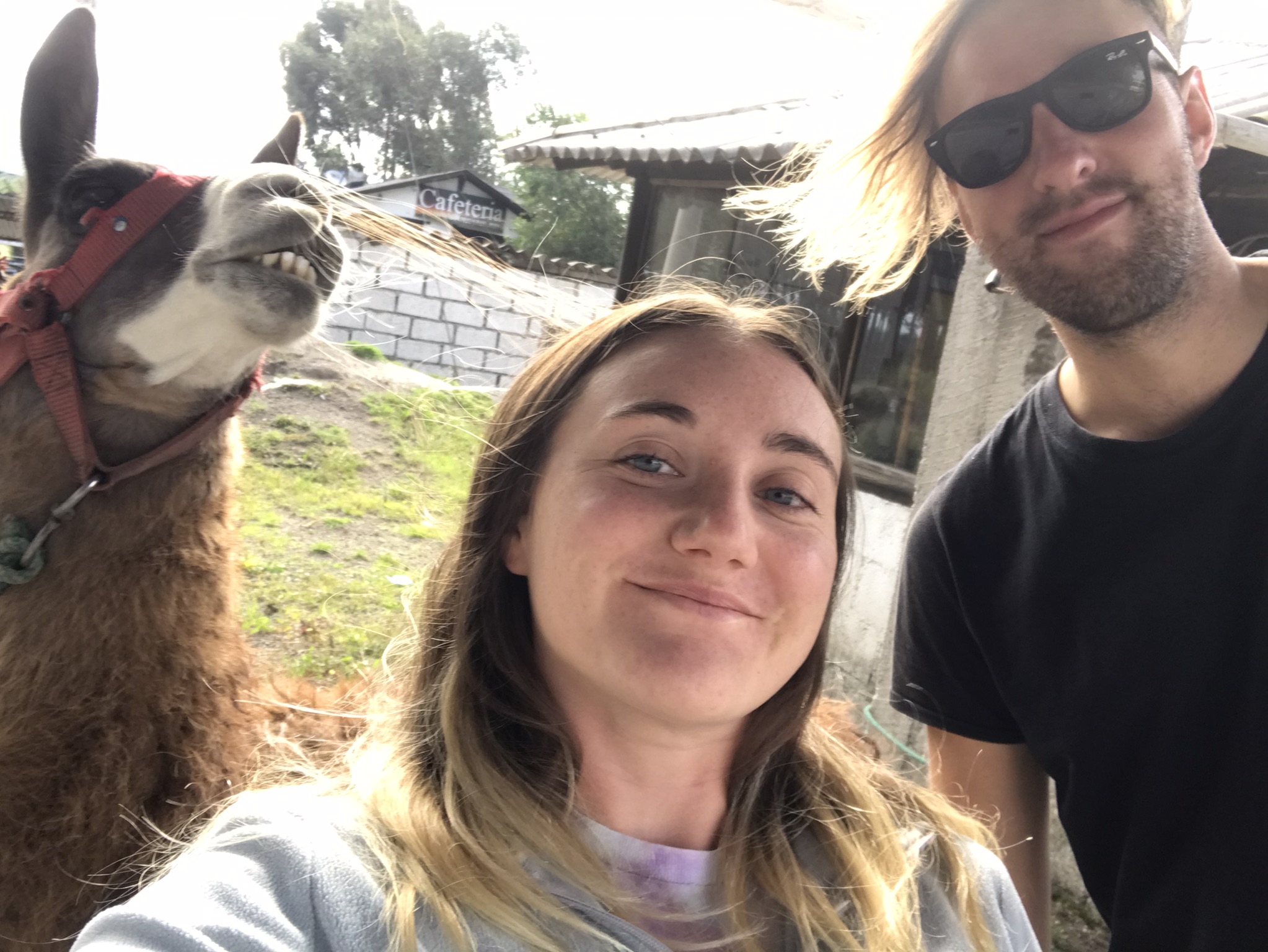Nicaragua is geographically the largest country in Central America but most of the major cities are situated in a relatively small area, along an almost vertical line in the far west of the country. Most tourists follow this well-worn gringo trail of Leon, Managua, Granada and Ometepe or vice versa. We did the same. Check out my Nicaragua travel experiences below.
Leon, Managua, Granada, Ometepe

The Spanish Fort, Lake Nicaragua
Nicaragua shares a border with Honduras to the north and Costa Rica to the south. Our walking tour guide in Leon informed us that Nicaragua is known as the land of lakes and volcanoes, however this only really applies to the more populated Western part of the country and other Central American countries such as Guatemala actually have more volcanoes than Nicaragua. The northeastern part of Nicaragua proudly boasts the second-largest rainforest in the Americas, the Bosawás Biosphere Reserve. We heard whispers about this untouched region of the country, it’s said to be an unspoilt paradise for wildlife. We briefly considered trying to reach this remote northern region but the infrastructure and transport links just aren’t developed enough yet – we predict this region will become more accessible to tourists in the future as awareness and demand grows, but for now it remains hidden and mostly inaccessible. The national currency of Nicaragua is the cordoba, named after Francisco Hernández de Córdoba who founded both Leon and Granada in the name of the Spanish empire in the early 16th century.
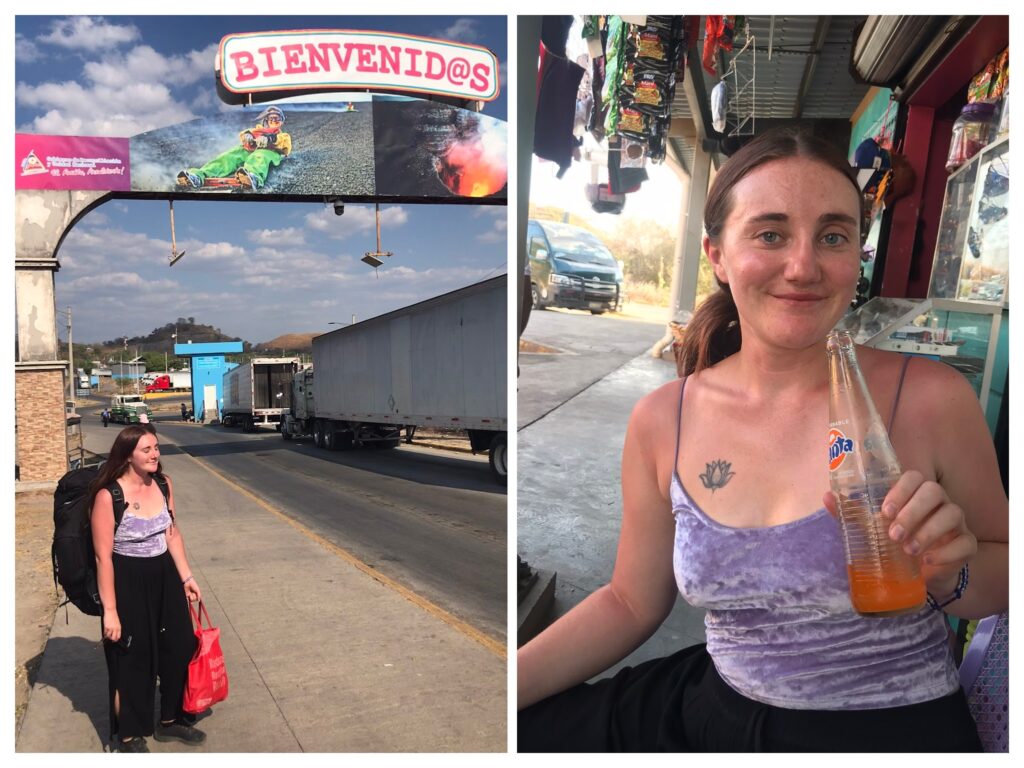
Sweating a lot at the Nicaraguan border
Nicaragua is a multi-ethnic country of people with mestizo, indigenous, European, and African heritage. Despite the strong Spanish influence in the west of the country, we were fascinated to learn that some communities on the Caribbean coast still speak creole or English as their first language. This region is known as the Mosquito Coast, named after the indigenous Miskito population that inhabit the eastern shores of Nicaragua and Honduras. You might ask why local people speak English there? Well, the Caribbean coastal areas extending from Nicaragua to Honduras successfully resisted Spanish conquest and Catholic conversion. During the 16th and 17th century, when the influence and power of Spanish was growing in the region, community leaders instead offered refuge to English and Dutch privateers (licensed pirates) in the Mosquito Coast. This led to the establishment of trade links and friendly relations with the British, and the region officially became a British Protectorate in 1655. Fast forward to 1860 and the British protectorate was transferred back to the independent Nicaragua to administer. The eastern regions of Nicaragua were given autonomous status by the Nicaraguan government in the 1980s and to this day they remain a distinct part of Nicaragua, proud of their enduring heritage and culture. The Mosquito Coast flag still features the Union Jack of Great Britain. While this region is also quite remote and difficult to access, people from the Mosquito Coast are very visible and present in other parts of Nicaragua and we encountered several people from this region in the cities in the west of the country.
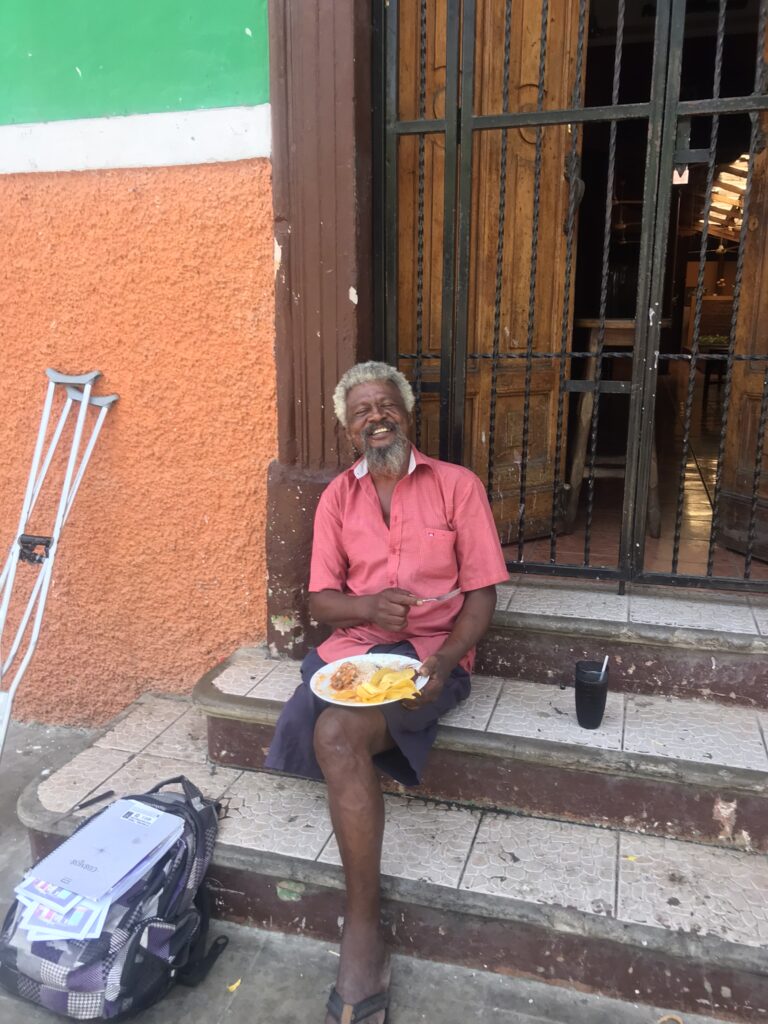
Whilst wandering around Granada I bumped into a man named John Oliver, a homeless poet living on the streets, who was from the Caribbean coast. He took great pride in telling me his ancestors were British and showing me his creole poetry.
Crossing the border into Nicaragua can be complicated. We found a lot of conflicting information online, in the end none of it was accurate, however we were randomly asked to show our yellow fever certificates! For more information on our border crossing experience, see my blog post here.
Nicaragua is a very hot country even by Central American standards. We visited in March and hadn’t quite anticipated exactly how hot it would be. As we hauled our backpacks across the bridge separating Honduras and Nicaragua, it honestly felt like we were walking in an oven. By the time we reached the Nicaraguan immigration office on the other side of the bridge, we were so drenched in sweat that we looked like we’d just had a bath. This was our first taste of what was to come. Every day during our time in the country the temperature was in the high 30’s (degrees celsius) and sweltering at night in the low 30’s. The heat was a real challenge for us in Nicaragua. It without a doubt affected our time in the country and our outlook of Nicaragua. It was difficult to sleep at night without the comfort of air-conditioning, especially in Leon. We found ourselves literally withering in the sun, hopping from one shaded spot to another to avoid direct sunlight. It was hard to drag ourselves out of the pool in Leon. Sight-seeing was rough as very quickly we became overheated, unable to focus and mildly delirious. Dan even suffered from heatstroke in Granada. Our walking tour guide in Leon compared Nicaraguans to volcanoes, quick to anger and liable to explode at any time. I would strongly suggest that the excessive heat doesn’t help this hot-headedness. After chatting with a local guy in Granada, he told me that Nicaraguans constantly complain about the heat. It sounds like Nicaraguans have something in common with the British, complaining about the weather!
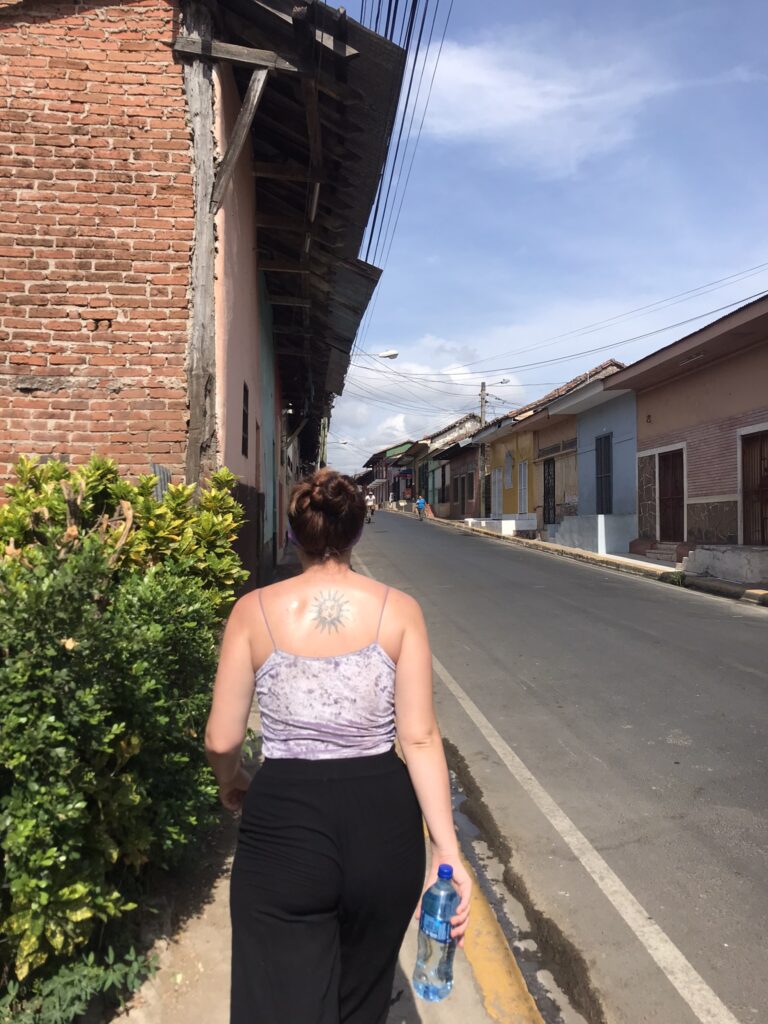
Braving the midday heat in Granada
The political situation in Nicaragua is complicated, with numerous revolutions and a history of American interference leading to a general distrust and dislike of America from the Nicaraguan government. Nicaragua has faced criticism by some in the international community for an increasingly authoritarian stance on free speech. We asked our walking tour guide in Leon what he thinks of America and he seemed pretty positive about the US. He did state that he could get in trouble for expressing his political opinions though which was slightly worrying. Foreign journalists are prevented from entering the country and the president has amended the constitution to allow for his re-election numerous times amid accusations that the country was quickly becoming a dictatorship. We even met locals from other parts of Central America who said they were scared to visit Nicaragua because of the political situation. All of this raises inevitable questions for travelers looking to visit the country. In our personal experience, when we visited it was common to see flags of the ruling FSLN (Sandinista) party displayed alongside or more prominently than the Nicaraguan flag. Apart from this, however, we didn’t find that the political situation interfered too much with our experiences of traveling through the country, or was really a factor at all in our daily experiences. The political history of Nicaragua is definitely interesting though and is difficult to ignore or overlook when visiting the country.
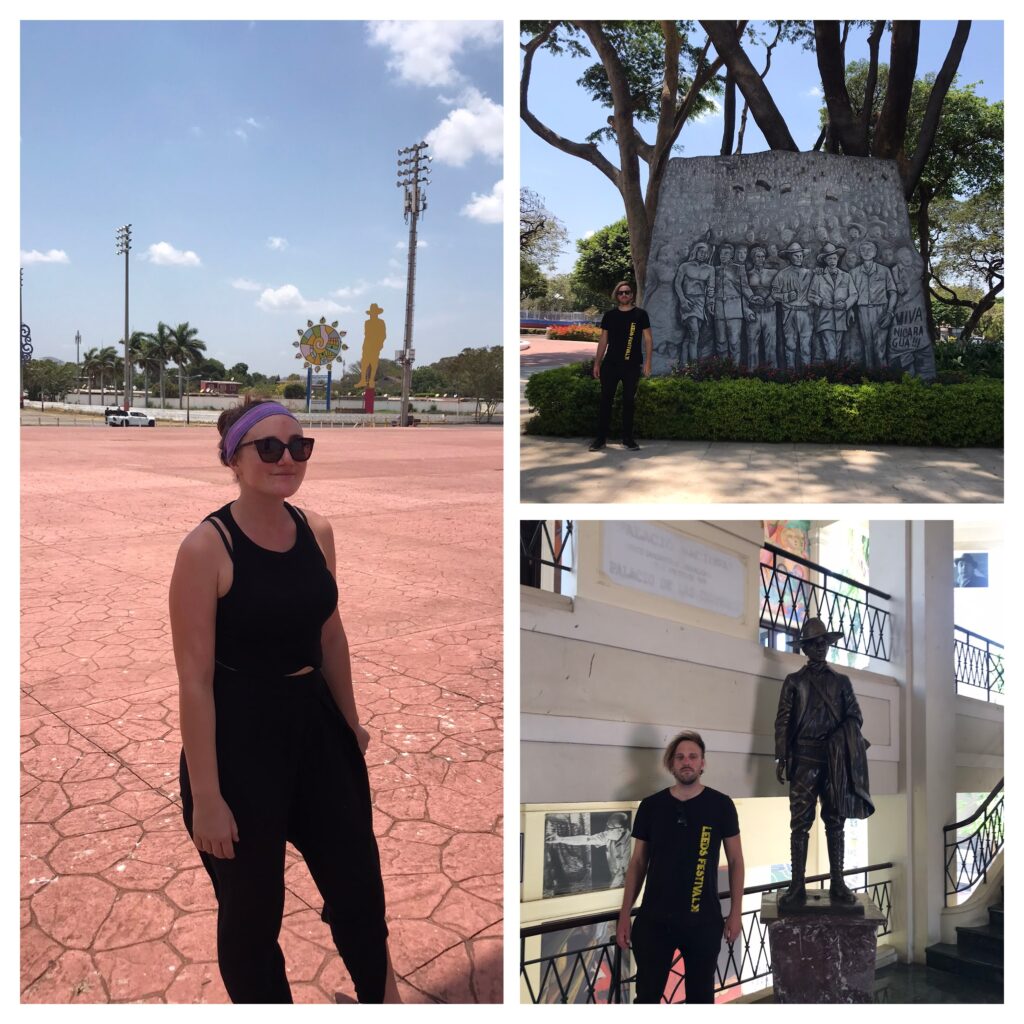
Everywhere you turn in Managua, you see either a statue of Sandino or an FSLN flag or memorial.
Every country has a national hero and Augusto César Sandino is presented as the national hero of Nicaragua, partly due to him being adopted by the Sandinista movement that has dominated Nicaraguan politics since the 1970s. Sandino was a revolutionary who fought against the U.S military incursion and local pro-American government between 1927-1933. He was the leading figure in the guerilla war against these combined pro-American forces and is well-known for his oversized hat and his assassination at the hands of the national guard. He is a martyr for Nicaraguan freedom and a figurehead for anti-American sentiment. The image of Sandino is absolutely everywhere, from huge cutouts darkening the skyline in Managua to statues in the National Palace and photos in the streets of Leon.
Nicaragua is a tale of haves and have-nots, with almost 25% of families living in poverty and more than 8% in extreme poverty, living on less than $1.25 a day. Wealth inequality is most evident in cities such as Managua, Leon and Granada. It’s not surprising to learn that El Salvador, Honduras and Nicaragua have the highest rates of migration, mostly illegal, to the US.
Leon
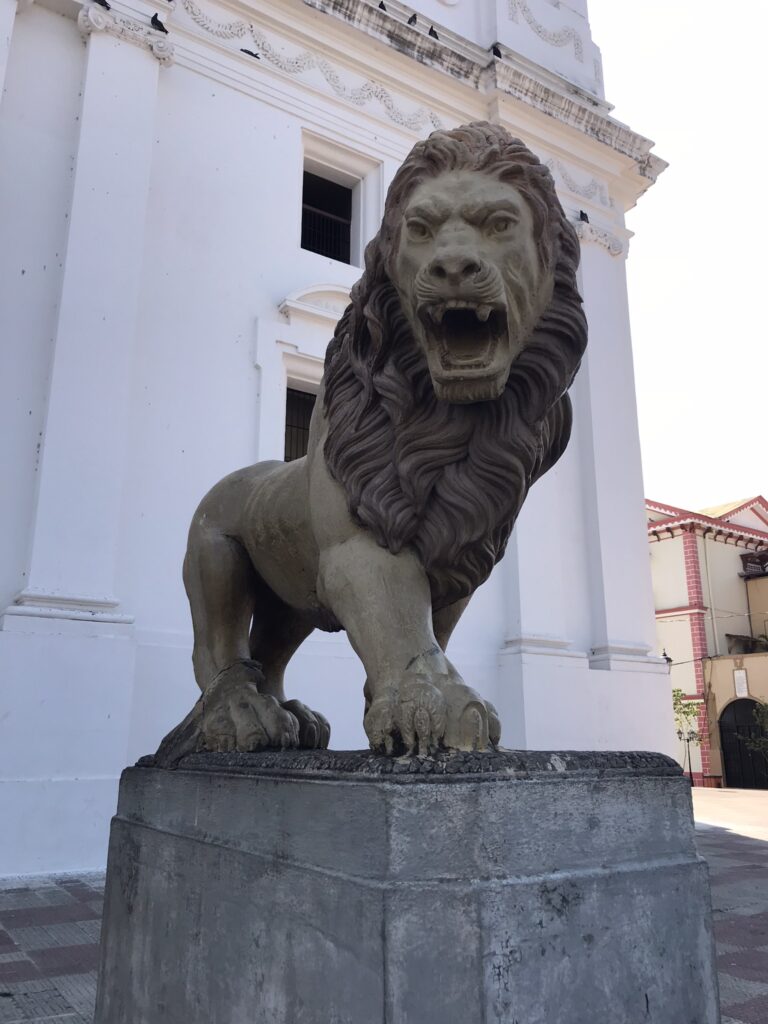
Leon is a charming colonial city in the north-west of Nicaragua. Despite its many historical buildings, the current city of Leon isn’t actually the original Leon – the city was originally founded on a different site which is known today as Leon Viejo. Leon Viejo was the city founded by Cordoba in the 16th century. Leon as we know it today was only settled in 1610 after the Momotombo volcano erupted and destroyed the old city of Leon. The modern city of Leon and Leon Viejo are around 30 km apart in distance. Leon Viejo has been named a UNESCO World Heritage Site; it’s still possible to see the ruins of the old city. Leon was also the home of Rubén Darío (famous Nicaraguan poet) and capital of the Sandinista movement until the fall of the Somoza dictatorship.
Leon has a long and historic rivalry with the other major Nicaraguan colonial town, Granada. Historically, Leon was the centre for Liberals whilst Granada was the seat of the Conservatives. The feud between the two for political prominence began in the early 19th century when both fought to be the capital of Nicaragua. During the 1840’s, civil war broke out over the dispute and the title of capital flitted between the two. The argument was finally settled in 1852 with Managua granted the title of being the capital of Nicaragua, Managua being approximately halfway between Leon and Granada. Leon has played an important role in Nicaragua’s history, and it is known as ‘capital of the revolution’ due to its role in many uprisings over the years. The streets of Leon are lined with memorials of those killed in the name of various revolutions.
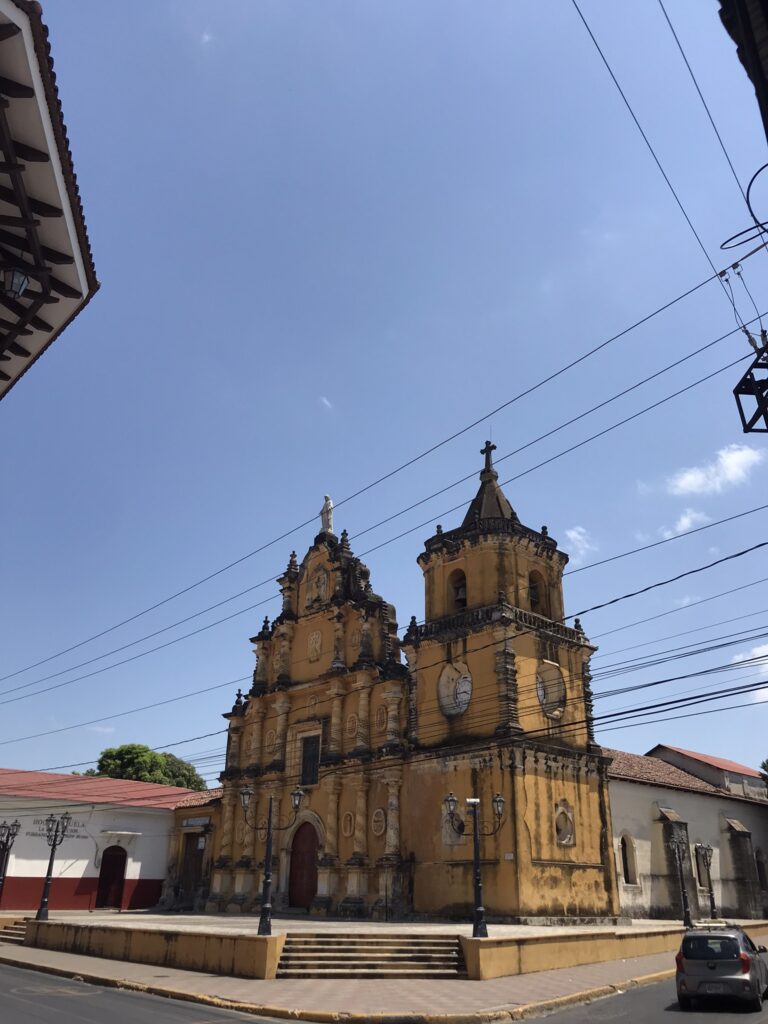
You can’t stay in Leon without visiting the Church of the Recollection
Leon is notorious for being the hottest city in Nicaragua and one of the hottest places in Central America, only the brave or foolish head there in the stifling summer heat. We actually met some backpackers who deliberately decided against visiting the city due to its reputation for heat. The heat in Leon was oppressive and did make it difficult to walk around and do much sightseeing in the town without immediately wanting to dart into somewhere with shade and air-conditioning.
The wealth of the city is centered around the main plaza but if you walk a couple of blocks away from the tourist hotspots the streets quickly transition into less polished, more gritty areas. This change was clearly visible when walking to and from the bus station at the Market Terminal. Behind the pretty façade of the colonial city, poverty is hiding just out of sight of the tourists. Our hostel was only one block away from the main square but one night we returned to find a homeless man sleeping outside the front door.
Leon is also the ideal place to stock up on any clothes you’ve lost in the laundry. One thing that I immediately noticed from walking around the city centre was the number of second hand clothes shops. All the clothes were well-presented and what I can only describe as ‘trendy.’ It’s great if you can’t resist a thrifty bargain.
Accommodation
Casa Abierta- Everything was great except the heat (important to note that we visited during a heatwave in mid-March). We were surprised to find that the breakfast wasn’t overpriced and was in fact very tasty! We particularly enjoyed the oatmeal with passion fruit option. The pool area was nice to hang around especially when it was really hot outside, it was a welcome respite from the heat. We only encountered one issue with the place and that was the heat inside the rooms. All private rooms are fitted with a solitary ceiling fan, this does nothing to help with the heat. We begged for an additional floor fan and we still weren’t able to sleep properly for the three nights we stayed. I would advise anyone like us who isn’t used to the heat in Leon to book a room with a/c.
Foodie Places
Casa Abierta – food is slightly more expensive than other nearby places but if you purchase food in the restaurant you get access to the pool. This is a particularly popular pastime with locals, who chug beers and lounge by the pool on weekends. It’s important to note the pool is closed to non-guests after a certain time at night. The restaurant is totally closed to outsiders on Mondays. The quality of the food and portion size won’t disappoint so if you’re staying nearby it’s a nice option for lunch or dinner.
Mañana Mañana Café – This was our go-to place for lunch and dinner; we ate here at least 3 times during our short stay. The food is affordable, more so than Casa Abierta, and super tasty. I fell in love with the caesar salad, it was absolutely massive with generous portions of chicken, egg and bacon.
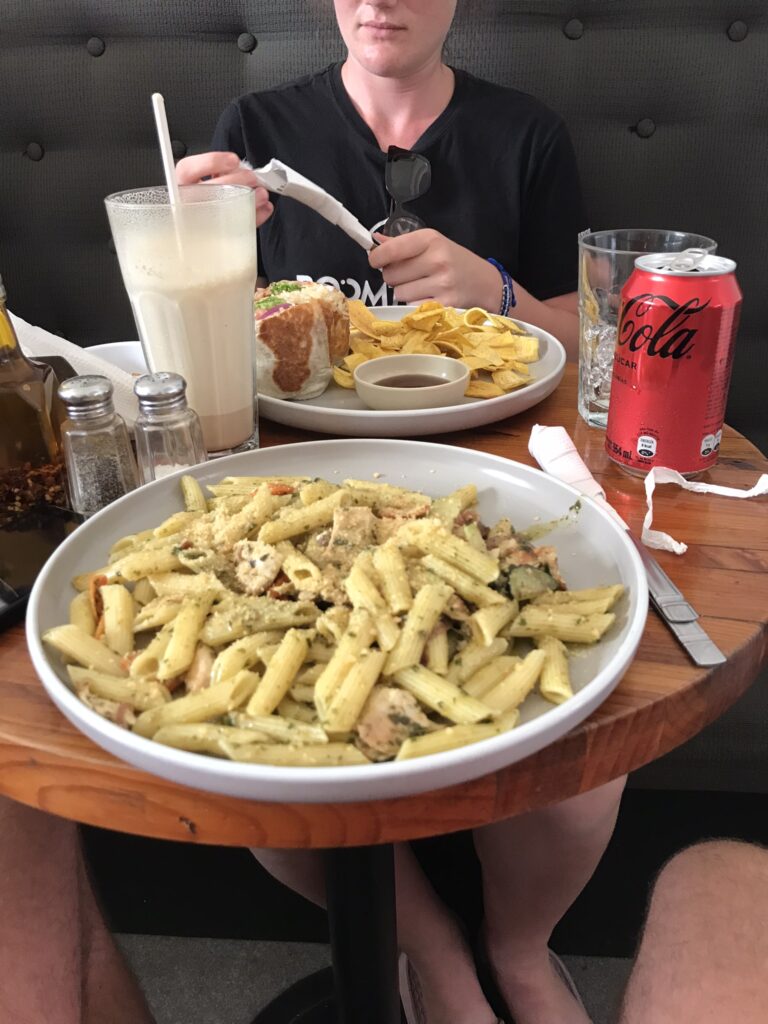
An impressive portion of pasta at Mañana Mañana Café in Leon
ViaVia León – We decided to try the food here while waiting for the volcano boarding tour to start. The waiting time was slightly longer than expected but the food was fantastic. I went with a chicken wrap which came with chips, salad and guacamole. The portion size was so big it could’ve fed two people!
Activities
Guruwalk City Walking Tour – this walking tour combined the standard sight-seeing route around the historical centre with a food tasting in the market. Each walker contributed a small amount into a shared kitty, this was then pooled to buy samples for the whole group. We really enjoyed getting to know and try local fruits and sweets, all while supporting local market-sellers and businesses. It was great to have a guide in the market as it can quickly become overwhelming with a proliferation of sights, sounds and smells. Other stops included: the Cathedral of the Assumption of the Blessed Virgin Mary (a UNESCO World Heritage site and one of the largest cathedrals in Central America), Cancha 23 de Julio (23rd July basketball court with interesting political murals), Hotel El Convento (a typical sprawling colonial home and an excellent example of a wealthy family residence complete with courtyard garden, it’s now a fancy hotel), Church of the Recollection (a vibrant-yellow church built in the late 18th century with a beautiful Mexican-Baroque style facade) and UNAN-León (the oldest university in the country).
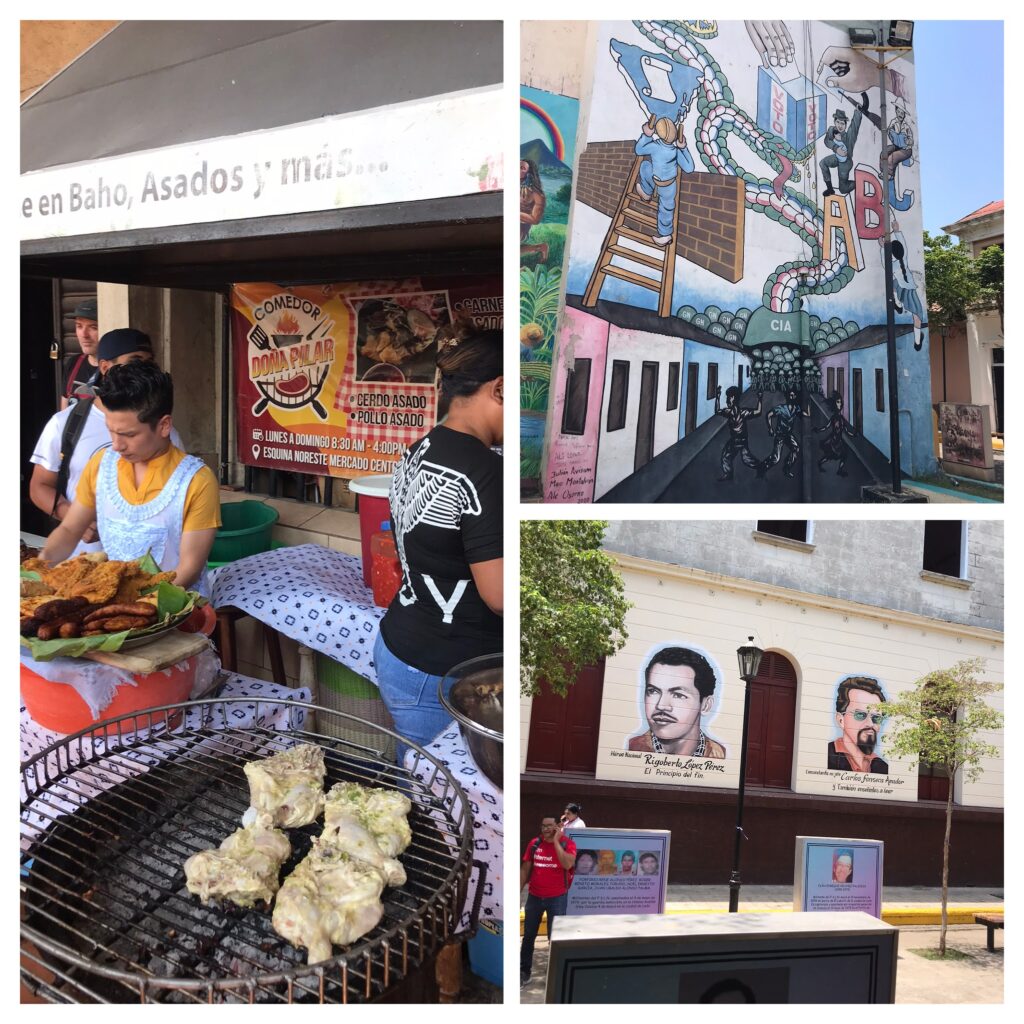
Scenes from the market, a political mural from the 23rd July basketball court and a memorial to revolutionary heroes
Cerro Negro Volcano Boarding with ViaVia hostel – Cerro Negro
Cerro Negro has the title of being one of the youngest volcanoes in the world. It’s called a cerro rather than a volcan (volcano in Spanish) because it’s under 1000m in height. The cerro is named negro (black) due to the dark colour of the young volcanic terrain which has not yet been covered by plants. The ground is loose volcanic rock and sand, it can be very slippery and slidey which is part of the fun. The loose ground acts almost like snow and so creates the ideal conditions for ‘volcano boarding’ – skidding down the volcano at high speeds on a custom-made wooden board. This is a popular activity in Leon and can be booked through most hostels in the city – we used the company Volcano Day based in ViaVia hostel which is one of the most popular.
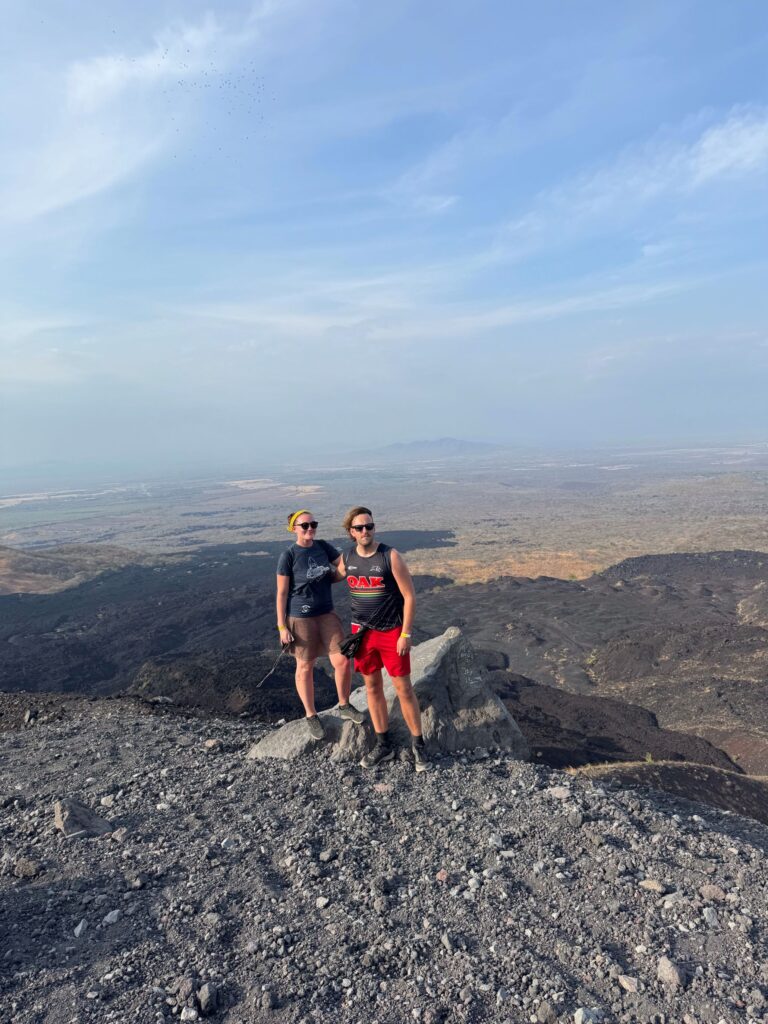
Catching our breath on the way up Cerro Negro
We didn’t really know what to expect from this activity; we hadn’t really looked into it before we booked. The most challenging part, which we weren’t prepared for, is that you have to carry your board (about 5-10kg) and equipment (boiler suit, goggles and gloves) to the top of the volcano, navigating unstable, steep terrain in 40C heat. We hadn’t anticipated this uphill march to the summit but it only took around an hour. It’s possible to pay for a porter to carry your board to the top for a small price. Your tour guide will arrange this when you arrive. The way down is much quicker! You can get some real speed whizzing down the cerro. The guide will go through safety procedures before you get on the board, talking you through how to sit on the board and, crucially, how to slow down. I ended up, mostly by accident, going so fast down the cerro that I arrived to a spontaneous round of applause when I reached the bottom. We did witness a couple of unsteady boarders in other groups skid off the track half-way down the cerro, but guides are posted along the route to help out if you happen to fall off or go into a spin.
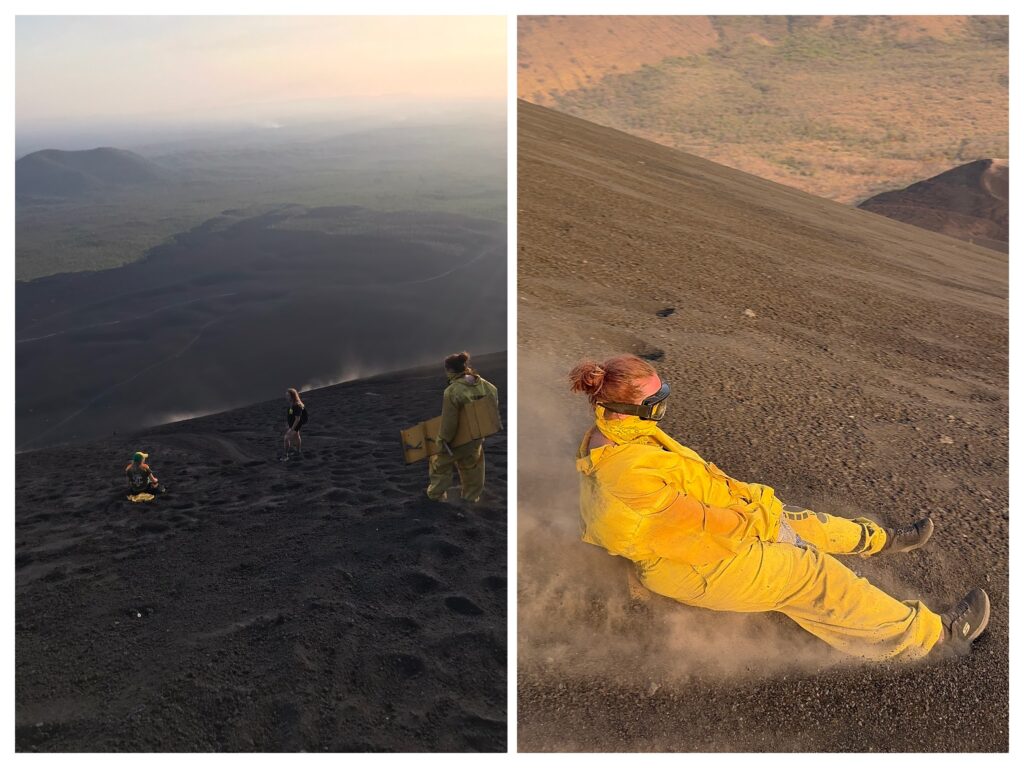
Try volcano boarding at Cerro Negro, if you dare!
Make sure you bring at least 1.5L of water, high SPF suncream and hat for the blistering trek. It’s also recommended that you bring a bandana, light scarf or t-shirt to wrap around your nose and mouth so you don’t inhale the volcanic dust on the way down. Expect to finish boarding covered in black volcanic dust, with volcanic sand in your shoes and volcanic dust residue in your ears. Also be aware that you will most likely cause some damage to the soles of your shoes during the activity, particularly around the heel area!
A vegetarian sandwich, fruit, toasted marshmallows and a ‘party bus’ were included in the price of the tour. After gazing at the sunset from the foot of Cerro Nego, we set off back to Leon with a quick stop to roast some marshmallows. I really enjoyed socialising around the campfire, toasting marshmallows to perfection (I’d never done this before!) and chatting about the experience with the other gringos. All aboard the party bus! The party bus was an experience in itself. I didn’t think I would like it but the party atmosphere was infectious and the complementary rum and coke helped to ease any initial uncertainty. By the end of the return journey, most of the passengers, myself included, were out of their seats dancing in the aisles with garish coloured lights illuminating the chicken bus and party anthems blasting out of the speakers.
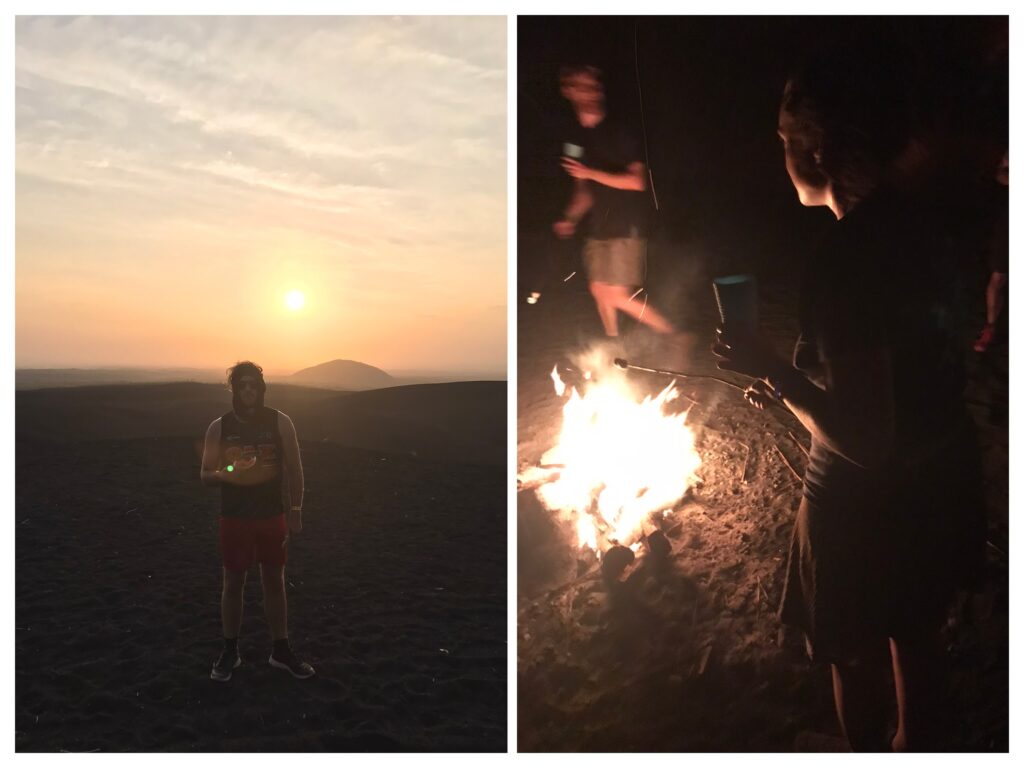
Making the most of the volcano experience
Rooftop tour of the Cathedral (Assumption of the Blessed Virgin Mary) – a great activity to do early in the morning or late in the afternoon. The rooftop provides 360 panoramic views of the city, overlooking the main plaza and surrounding side-streets. Be aware that the rooftop is totally exposed to the elements so I would recommend against visiting in the scorching midday sun. You’re also not allowed onto the rooftop with shoes, in order to protect the roof you are only permitted to step out onto the roof in socks. Confusingly, the ticket office for the rooftop visit is at the back of the Cathedral, once you’ve bought the ticket you then need to exit the ticket office and enter through a small door on the south side of the building. It is also not actually a ‘tour’, you just visit the rooftop and walk around at your leisure. The whole process of purchasing the tickets was needlessly confusing. The rooftop is also closed at certain times. It’s a bit of a minefield really for such a simple activity.
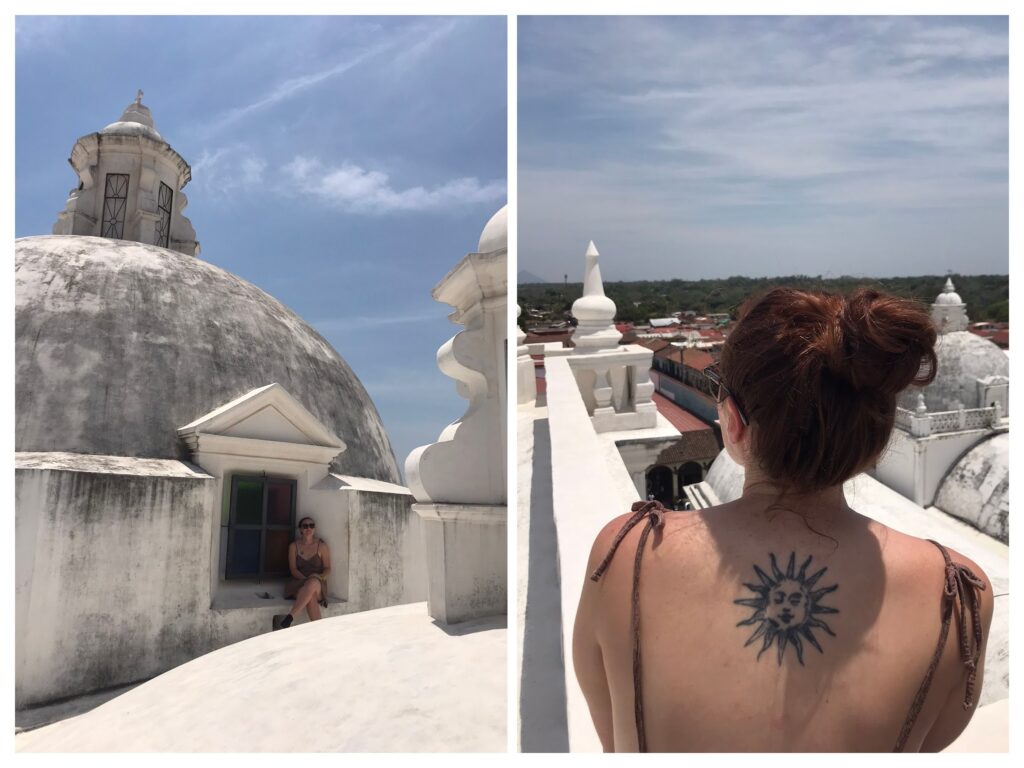
If you’re heading to the Cathedral rooftop, don’t forget to bring sunglasses as the glare from the white rooftop is almost blinding without eye protection
Pub quiz at Viavia Hostel – A dubious pub quiz to say the least! After being invited to join in by the announcer, we bested all the other teams and should’ve taken first prize. However when it actually came to the finale, apparently we were tied. This was obviously fiddled! Dan and another guy were then tasked with downing a drink to decide who would take first place. Dan drank his beer in half the time of the other competitor but since there was a drop in the bottle when he turned it over, the win was given to the other guy. The pub quiz seemed to be a sham and we were set up to lose (although we still were given a consolation prize which was basically the same as the prize for winning). It was also fishy that other teams seemed to win far more prizes on the raffle than us. I understand that they want to encourage locals to enter the pub quiz and raffle but I wasn’t so happy about being cheated. The quiz and raffle are good fun as long as you can accept that you probably won’t come first or win as many prizes as the other Nicaraguan contestants.
My Leon content is now available on GPSmyCity!
Managua
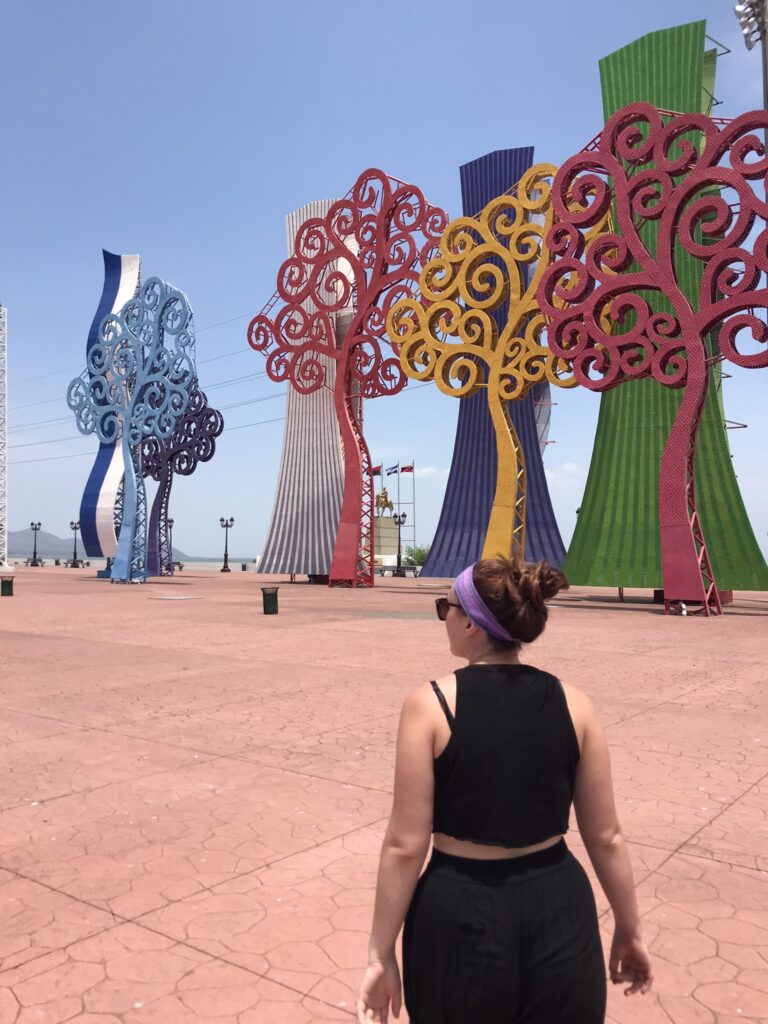
Managua is located on the shores of Lake Managua. It’s the largest and most populous city in Nicaragua. Managua has been the capital of the country since 1852 after a compromise was reached between the two rival cities of Leon and Granada. A catastrophic earthquake destroyed 90% of the downtown area of Managua in 1972 which means that the city has few historic buildings. Only the Cathedral, National Palace of Culture and Ruben Dario theater survived with varying levels of damage sustained. Managua is a modern city with multi-lane highways running through the centre and wide pavements lining the roads.
It’s easy to read blogs about the dangers of Managua and scare yourself silly before you even arrive. We had no problem walking around the city center during the day, nobody hassled us or even approached us. We spent most of our time in or near Revolution Plaza; the area wasn’t crowded or dodgy at all, in fact it was strangely deserted.
Collectivos arrive from Leon and depart for Granada at this terminal.
Accommodation
Like all capitals in Central America, Managua has areas that are safer than others. It’s important to do some prior research and book accommodation in a safe, affluent area of the city. By staying in a low-crime area, you reduce the likelihood of becoming a victim of crime. La Posada del Arcangel is located in one of these safe areas and is within walking distance of all the main attractions I mention later in the activities section. Arcangel was the perfect oasis after the relentless heat of Leon, with air-conditioning in all rooms and an air of tranquility. It felt like walking into an affluent family home, the walls were absolutely brimming with imaginative art pieces and the cabinets were filled with antique ceramic pieces and quirky ornaments. The place almost felt like an art gallery and museum rolled into one. Usually in hotels, the art is displayed behind glass to prevent any damage from occurring by hotel guests, this wasn’t the case here. I even caught a glimpse of the resident artist who was responsible for filling the walls with his own art. The room itself was comfortable and clean and the breakfast was pretty good – zero complaints from us.
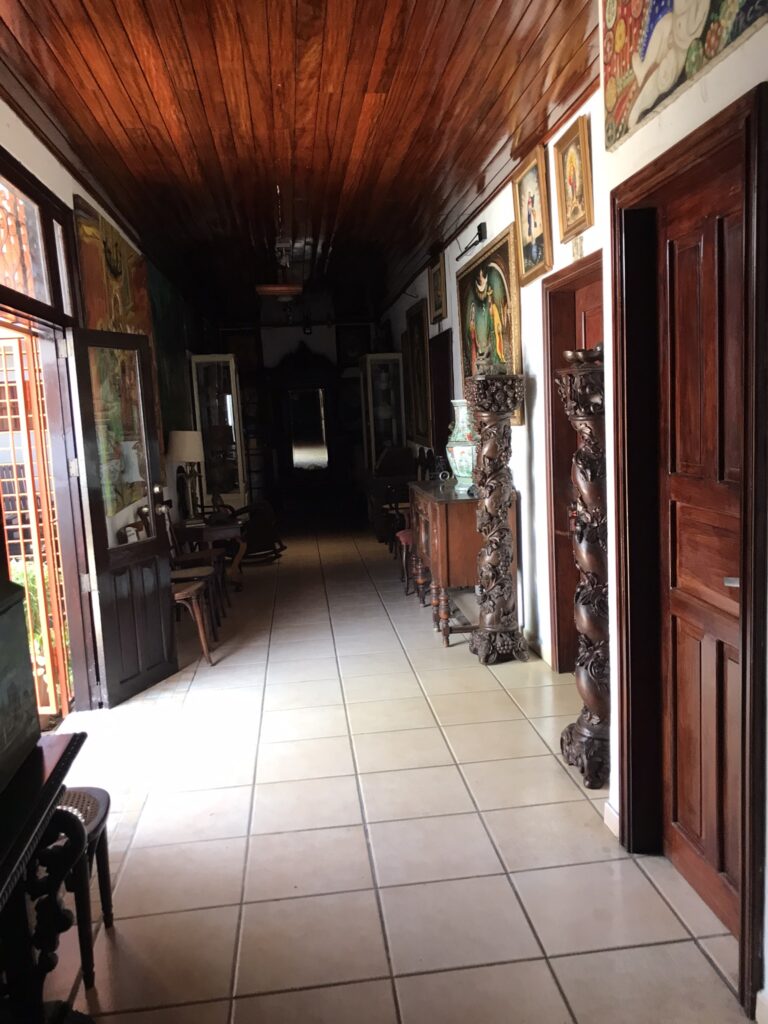
The corridor of La Posada del Arcangel
Foodie Places
Little Caesars Pizza – Little Caesars Pizza seem to be everywhere in Central America. We didn’t want to tempt fate by walking around the city at night so we got a Little Caesars Pizza delivery. They’re an excellent option for cheap, takeaway pizza.
Subway – we couldn’t resist getting a Subway in the Plaza Inter shopping mall – guilty as charged! The food court at Plaza Inter has a lot of Western and local fast food options.
Activities
GPSmycity walking tour around the city centre with stops including:
Teatro Nacional Rubén Darío – this theater was named after the famous Nicaraguan poet.
The Managua Seawall overlooks Lake Managua, it’s famed for the huge, funky metal tree sculptures that line the promenade – I’m still not sure why they didn’t plant real trees instead!
Revolution Plaza- In 1979, Nicaraguans gathered here to celebrate the end of the Somoza regime. It’s still possible to see bullet holes on the facade of the Cathedral, a visible reminder of the armed struggle to defeat the National Guard and seize control of the city for the Sandinista movement. Now it’s a very odd place, no longer filled with people – tourists and Nicaraguans alike. It’s the main square of the country but it’s eerily quiet.
House of the People – formerly the main presidential palace, the president moved out of this palace recently and ‘gave it’ back to the people, I highly doubt that ‘the people’ in question could even enter the grand building. It just stands deserted in Revolution Plaza.
Santiago of Managua Cathedral – condemned in 1972, the cathedral has a bit of a haunted house vibe, it’s completely derelict with a caved-in roof and exterior damage from earthquakes, fires and shelling. The building is screaming to be renovated. We found it strange that there’s still guards outside that stop you from entering.
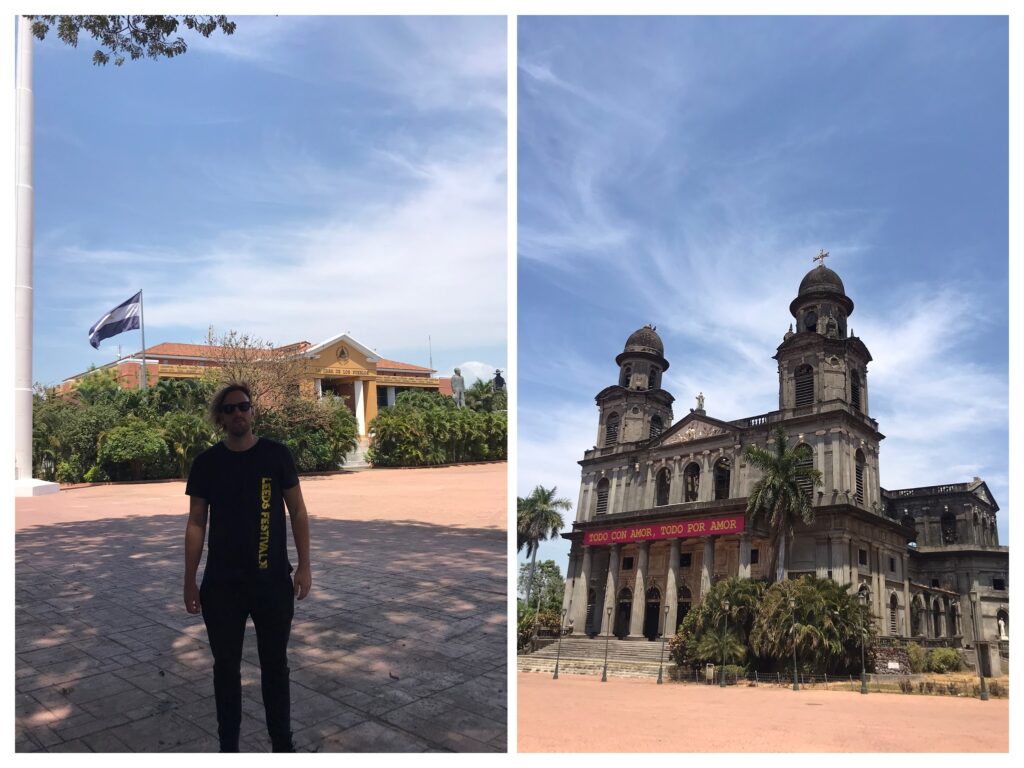
House of the People and the old ruined Cathedral are both in Revolution Plaza
Central Park with Music Temple and Mausoleos Fundadores FSLN – some interesting monuments to have a look at which commemorate the FSLN’s armed struggle to rid Nicaragua of the Somoza dictatorship.
Palacio Nacional which houses the National Museum featuring cultural and historical artefacts and artwork. Well worth a visit if you’ve got a free morning or afternoon.
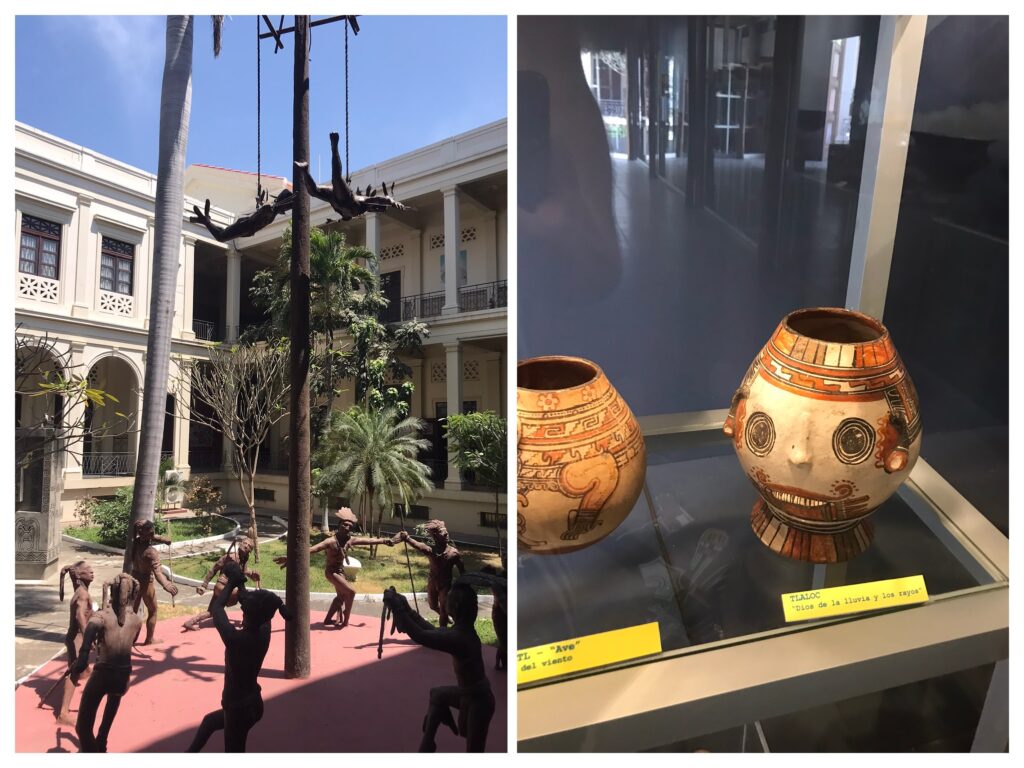
Inside the National Museum
Arboretum Nacional – if you’re looking for some real greenery in the city (rather than the huge metal trees), head to this quaint park for some much needed nature. Many native trees and shrubs have been planted in the arboretum for visitors to glance at or take some time to reflect amongst the trees.
My Managua content is now available on GPSmyCity!
Granada
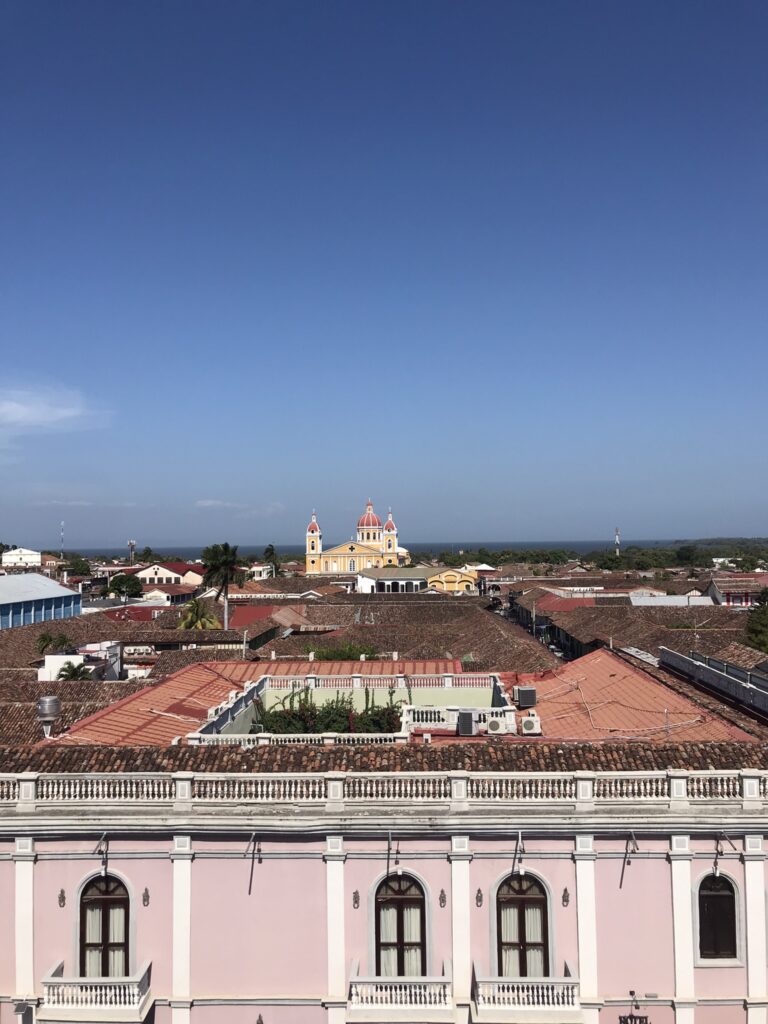
The oldest colonial settlement in Nicaragua, this city was founded by Francisco Hernández de Córdoba in 1524, swiftly followed by Leon Viejo in the same year. The city boasts a rich colonial heritage as evidenced by the exquisite architecture still present to this day. Its network of streets and plazas follows the archetypal block layout as seen over and over again, replicated in every colonial city. One of the most iconic buildings in the city is La Catedral de Granada, a neoclassical masterpiece featuring a mustard yellow façade and white column design. This yellow-hued building immediately brings to mind other Moorish buildings in southern Spain. Granada was named after the city in Spain to celebrate the defeat of the last bastion of Islamic forces in southern Spain, completing the ‘reconquista.’
Granada perches on the shorefront of Lake Nicaragua, the largest lake in Central America. Gazing out from the shores, it’s easy to mistake this humongous lake for the sea.
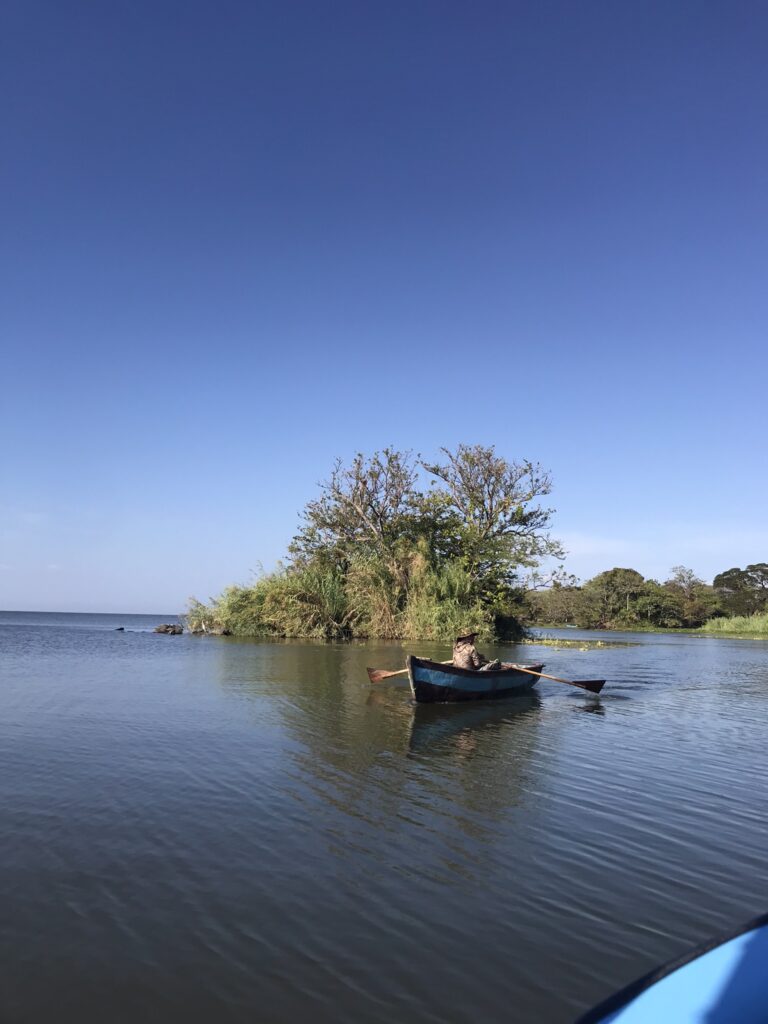
A fisherman on Lake Nicaragua near Las Isletas
We were surprised to find out that there’s a thriving expat community in Granada. Personally, it would be too hot for me to live comfortably.
Accommodation
Hostal Azul – this hostel has a shared kitchen, pool and breakfast included in the price. We found that there was a social atmosphere without it being too noisy after 10pm. This hostel is only 2 minutes walk away from the main plaza, and is ideal for those that prefer to be in the centre with an ample choice of restaurants and cafes nearby.
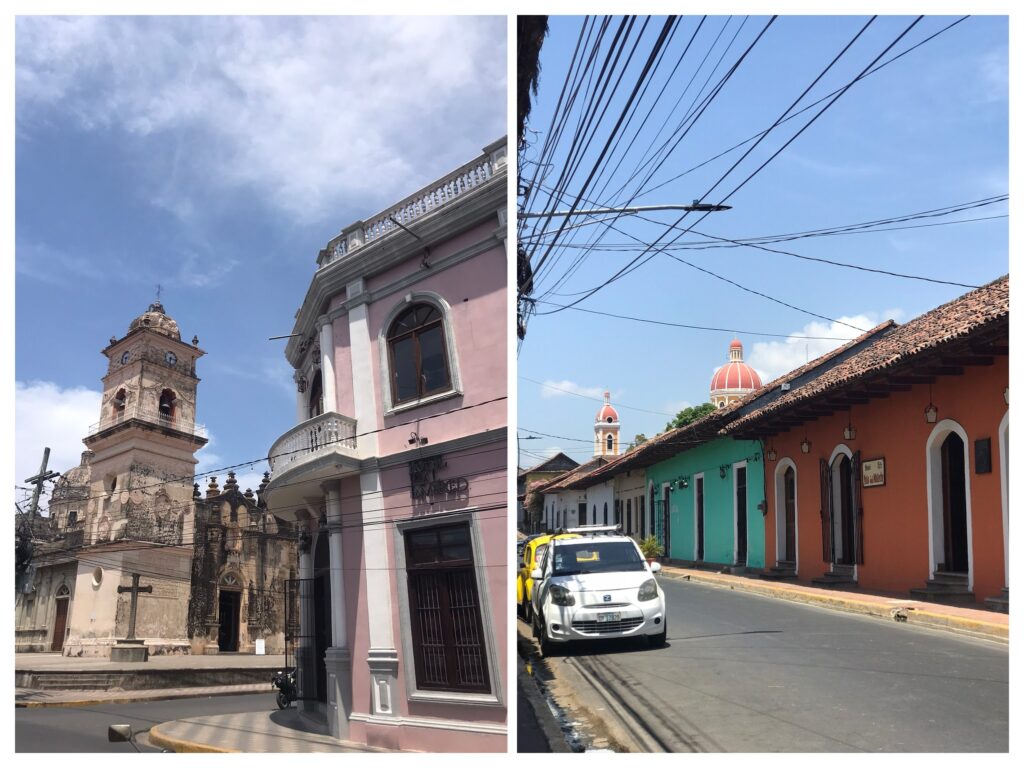
In Granada you’ll find a lot of hostels have taken over old colonial buildings
Museito de Carlos – More like a homestay than a hotel. Carlos and his wife welcomed us with open arms into their home. The couple were very hospitable and tried their best to talk to us with limited English. When you first walk through the front door, it feels like you’re entering your grandparents home. The walls are cluttered with an array of art and various ‘bits and bobs.’ Carlos proudly showed me photos of his granddaughter and explained where his children now lived, spread across the world. When returning from dinner, sometimes we caught the couple asleep in their rocking chairs in front of the television! Carlos’ wife makes the breakfast, which was always tasty and filling. The bedrooms are clean and spacious with air-conditioning. The only downside is that the place is slightly out of town centre (10 minute walk from the main square), the short walk feels like 100 miles in the scorching midday sun. Staying here instead of at a sterile hotel was much more enriching though.
There is a temptation to stay at the Selina hostel in Granada due to its prominence and location. It’s located right in the main plaza, on the opposite side of the square from the Cathedral. If you’ve never heard of the Selina brand I’ll enlighten you; it’s a well established hostel chain with hostels throughout Central and South America. We’ve encountered numerous Selinas in various towns and cities along the way. It has a reputation as a trendy, more boutique hostel with co-working spaces, social activities and fantastic backpacker services. It’s usually more pricey than other hostels but generally provides good quality accommodation. I would imagine Selina hostels are a great place to meet other backpackers if you’re traveling solo. We tend to avoid the Selinas as they usually appeal to a certain type of traveler, and staying in this sort of place often doesn’t provide the most authentic experience. I would recommend staying elsewhere to avoid the Selina bubble.
Foodie Places
Restaurante El Garaje – a sandwicheria run by an American expat couple out of their kitchen. If you’re craving American-style sandwiches such as buffalo chicken, pulled pork or a Cuban Sandwich, this is the place to come for lunch! It’s only open at lunchtime so arrive early to avoid disappointment. It’s important to remember that the price doesn’t include tax so be prepared to pay more than it says on the menu.
Smiles Coffee – A place everyone should visit in Granada. Smiles Coffee is only open for breakfast and lunch, closing in the early afternoon. It’s a community initiative set up to support those in the deaf community, providing jobs and allowing them to be financially independent and interact with customers. Some work in the cafe whilst others develop weaving skills to make things to sell. There’s a shop selling these woven products at the front of the cafe. What makes the place so special is that it promotes understanding and the building of connections between the non-deaf and deaf community. On the walls of the cafe, you can find helpful phrases, numbers and the alphabet in sign language. Customers are encouraged to communicate in sign language to say thank you. The menu contains instructions on how to order without speaking to avoid any miscommunication. The food was very tasty and quite cheap too which was a plus!
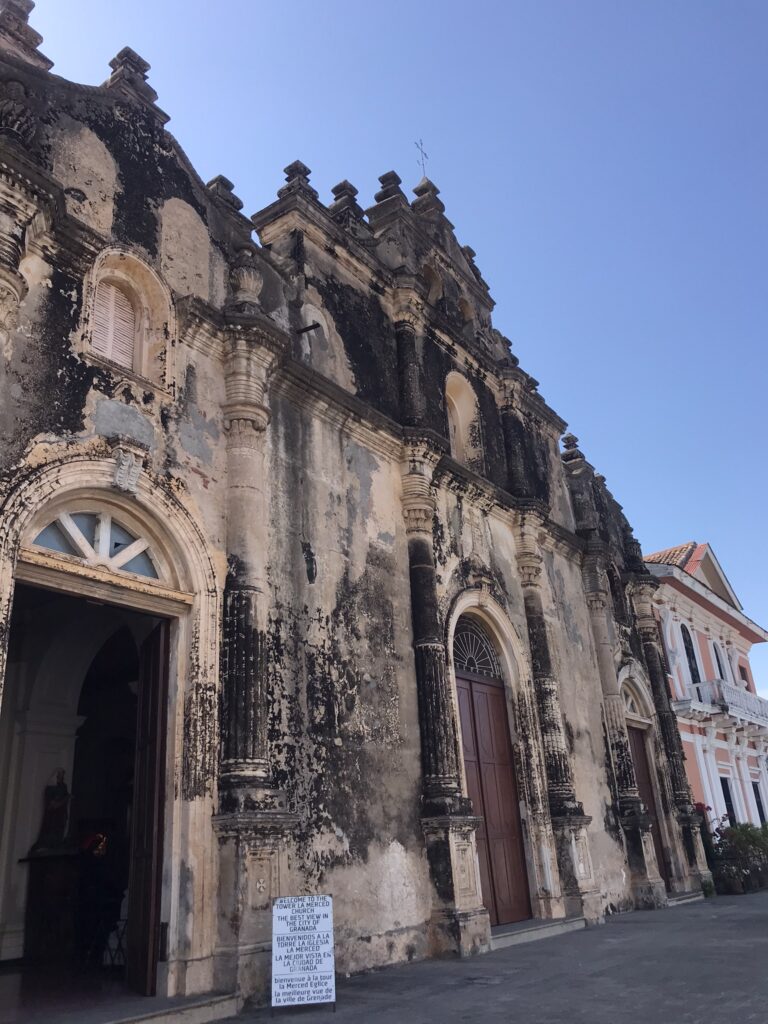
Smiles Cafe also happens to be right next to the Church of Mercy
Burrocks – Comida Mexicana – This place is an unpretentious eatery serving cheap, filling Mexican fare. We visited Burrocks twice in 3 days and never came away disappointed. It’s the ideal place to stop by if you’re looking for cheaper food to fill up on. We particularly enjoyed the burritos as well as the rock music being played from the speakers, giving the place its name. You won’t find avocado toast here, that’s for sure!
Chocolate Museum of Granada – If you’ve got a craving for chocolate, look no further than the Chocolate Museum. It’s a great place to satisfy all your chocolate needs with chocolate drinks, chocolate desserts and even chocolate tea on the menu. My favorite was the iced chocolate drink with added cinnamon. Delicious and so refreshing in the heat!
La Sultana y el Café – The quality of the food was excellent here. The carbonara was to die for! Again, our bill came to more than we expected because of the additional tax not included on the menu.
Activities
Guruwalk City Walking Tour with stops at Cathedral, Malecon, Parque Guadalupe, Church of Mercy, Calzada Street (the main pedestrian street lined with restaurants and hotels, a hotspot after dark). We were surprised to find that there weren’t many Guruwalk walking tours in Granada. I wouldn’t recommend the walking tour we took as it was kind of strange. I really struggled to understand the guide. We’re still not entirely sure if he was a legitimate guide. He invited us to join his group after our original tour was cancelled at the last minute.
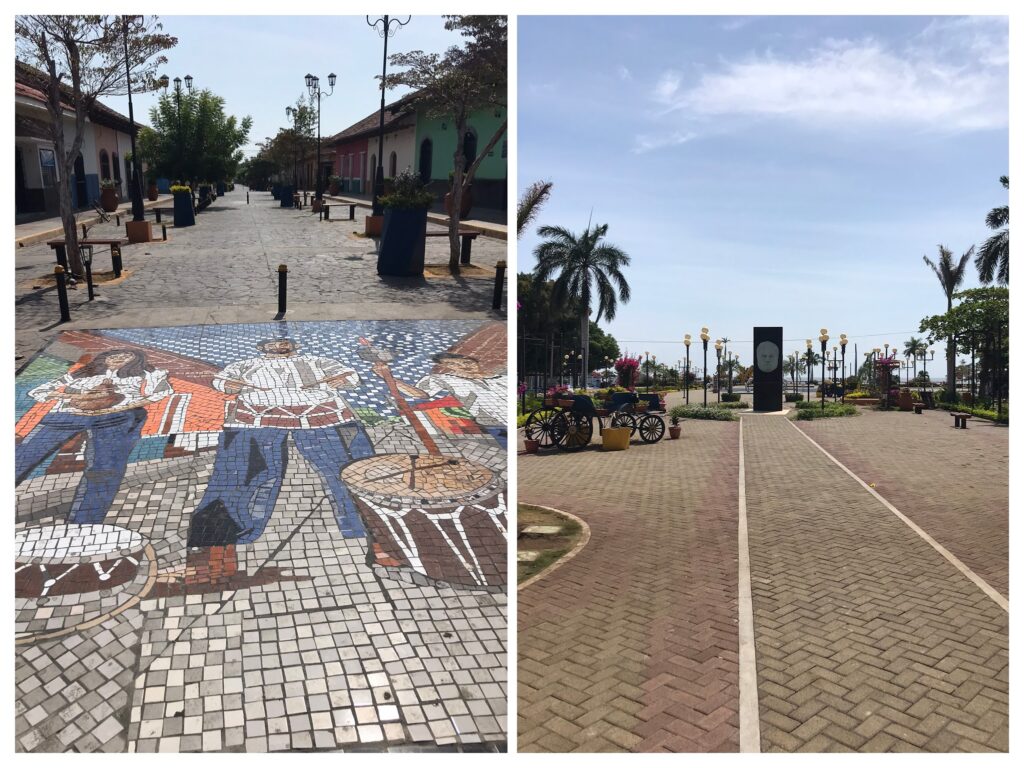
There are some interesting mosaics along Calzada street and great views of Lake Nicaragua at the malecon
Lake Apoyo day trip booked via Cueva Nica Hostal – Lake Apoyo is the largest volcanic lagoon in Nicaragua. It’s a popular destination for travelers and locals alike. Spending time in the lake is a welcome relief from the constant heat. The day trip included transport and entry to Paradiso Hostel & Restaurante, a popular lake-side hostel. The day pass included use of inflatable rings, paddle boards, kayaks, sun loungers, table tennis and a pool table. The beach area and restaurant were particularly busy when we visited at the weekend, so I would recommend visiting during the week if you want to avoid the crowds. Another thing to point out is that all food and drink must be ordered using a tab system, when you arrive you’ll be issued with a card and you need to pay your tab when you leave. It’s very easy to get carried away with spending when you’re not physically handing over cash or paying on card straight away. My advice is to keep an eye on your bill so you’re not surprised at the end!
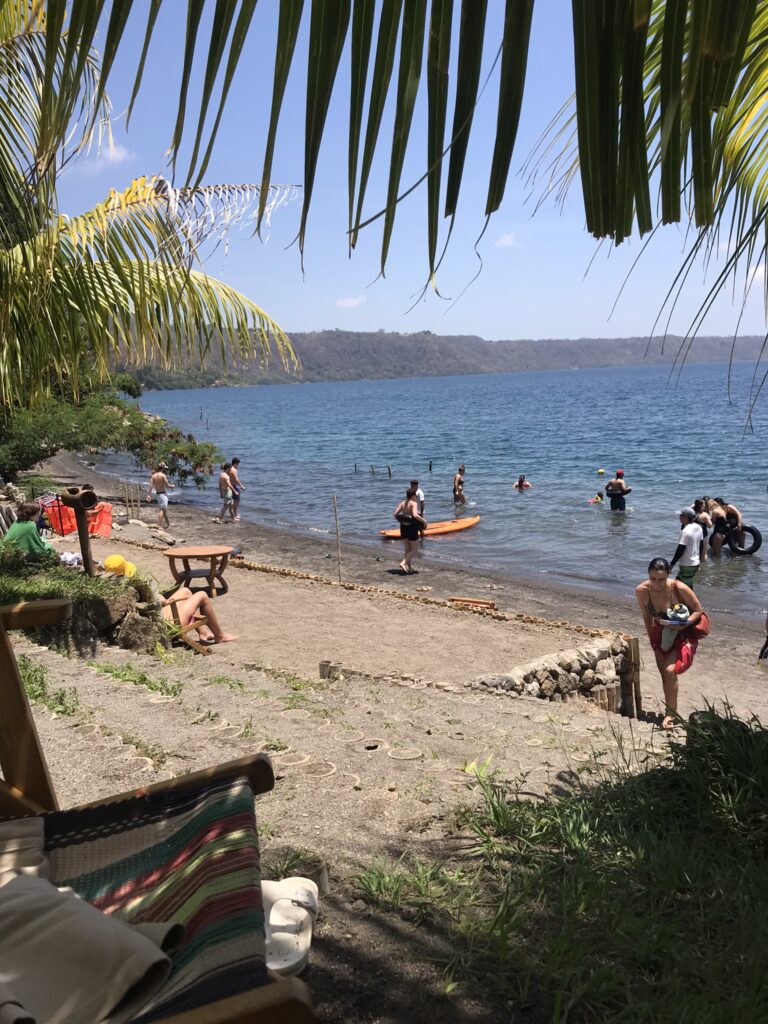
The view of Lake Apoyo from our sunlounger at Paradiso Hostel
At Paradiso, we bumped into a steak-eating American expat who now calls the area home and he told us about how pure the lake water was (very pure!). He said there are now rules in place to stop sewage and wastewater being released into the lake. We also found out that you can only build on the grounds of a previously built property i.e. new buildings have to follow the layout of older buildings that are demolished. This means there can’t be any huge tourist resorts or mega-mansions. What a relief! The government has also prohibited the use of motor-boats on the lake to prevent any pollution. It seems like the government has really stepped in to preserve the natural beauty of the lake.
Las Isletas boat trip booked via Cueva Nica Hostal
There are 365 islets close to Granada in Lake Nicaragua. Some are very small and others large enough for luxurious mansions. This smattering of islands was formed when nearby Mombacho volcano blew its cone. Our guide joked there was an island for each day of the year. Many of the isletas have now been converted into private islands for the wealthy elite. We learned that some locals still live on some of the islands, although many have left for a better life elsewhere. Locals are often offered irresistible amounts of money to vacate their land. The pressure to accept vast sums of money (vast in proportion to their daily income) and move elsewhere is a constant temptation. Our guide said that there are schools and restaurants on the islets for local families, and we did see a number of locals and fishermen amongst the islets however the population numbers are dwindling. Most of our boat trip was spent gawking at the private islands with opulent residences perched atop them, with our guide pointing out which islands were for sale and how much they were on the market for. Our guide informed us that some of the private islands belonged to eminent Nicaraguan families and even a handful of foreigners.
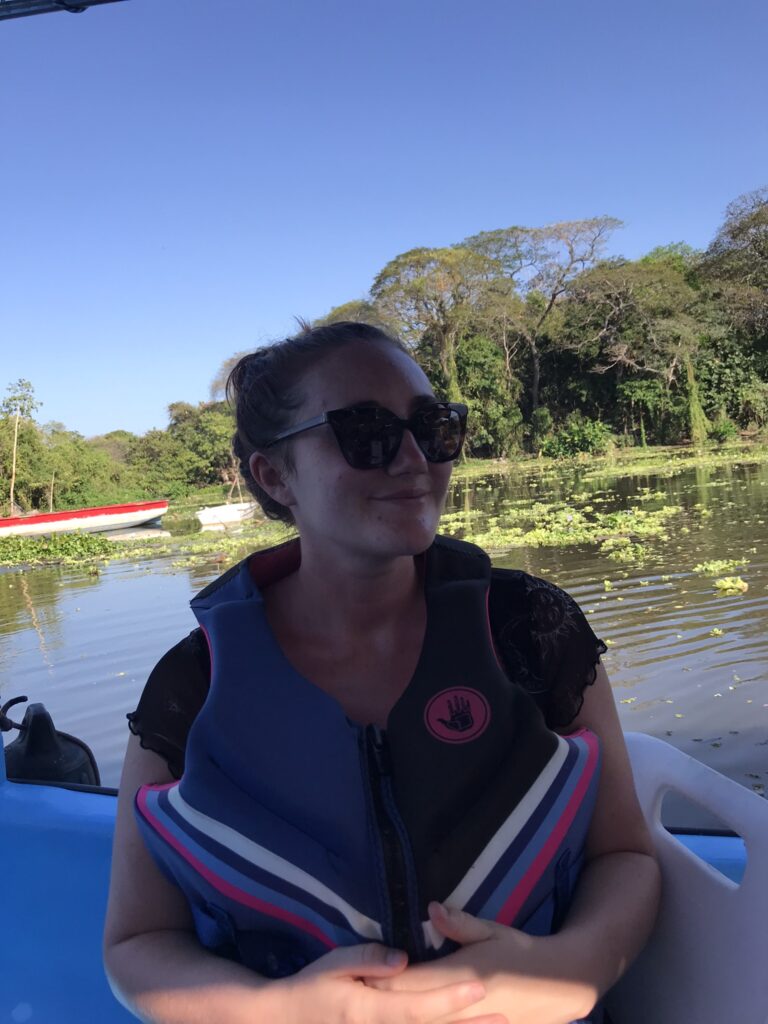
A boat trip around Las Isletas is a relaxing way to spend the afternoon
Las Isletas are also a good place to spot some wildlife. We were lucky enough to spot a kingfisher perched on an electricity line, a few monkeys on the aptly-named ‘Monkey Island’ (some were sadly missing their tail because they’d accidentally caught the electric line) and plenty of cranes and other typical birds. After passing numerous islands we arrived at the Spanish Fort, this building was used by the Spanish as a military lookout in case of pirate attacks. Interestingly, the Spanish Fort is actually on a public island rather than a private one and is owned by the Nicaraguan government, meaning we were able to get off the boat here and take a look around the island. It’s the perfect place to watch the sunset over Granada in the distance.

A magnificent sunset from Las Isletas
Church of the Mercy – you can climb the belltower here for fantastic views over the city. You can even spot the top of the Cathedral above the rooftops.
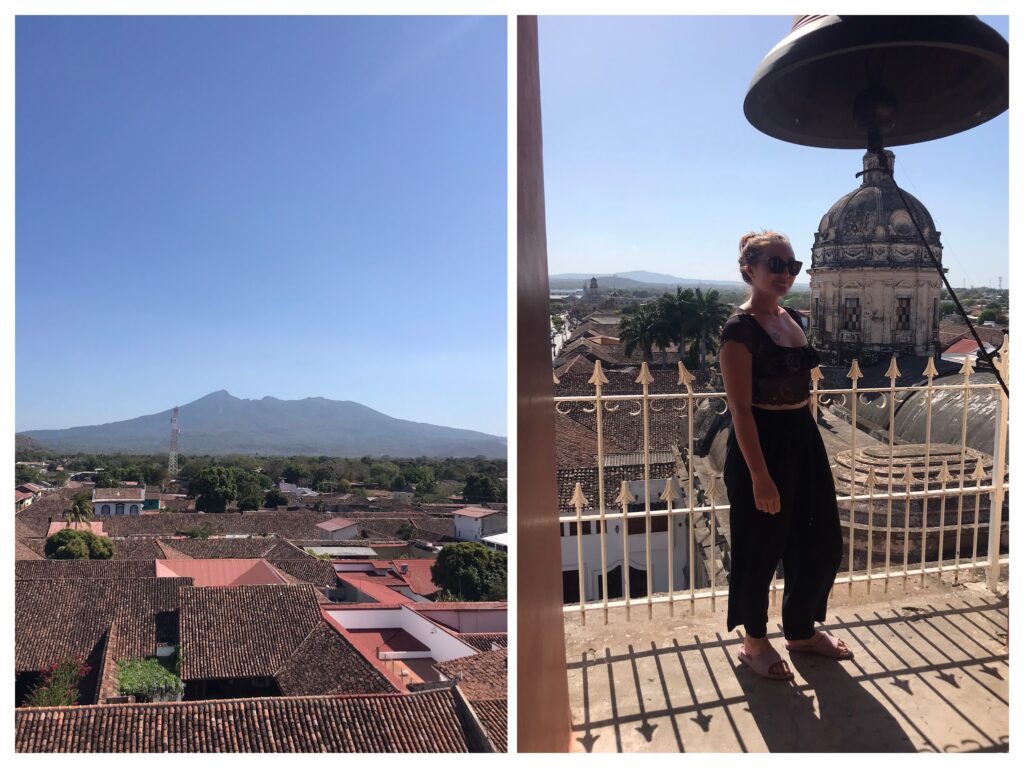
The belltower provides a nice shaded spot to view the city from above
Another favourite activity for travelers just outside of Granada is Masaya Volcano. Thrill-seeking tourists head to Masaya to admire the view of the crater and lava river inside. Most tour companies in Granada advertise evening trips to Masaya so you can admire the glowing-red lava after sunset as it’s more visible in the dark. Sadly, the park was closed for visitors during our time in Granada as part of the crater had collapsed so unfortunately we didn’t get to see this for ourselves.
My Granada content is now available on GPSmyCity!
Ometepe
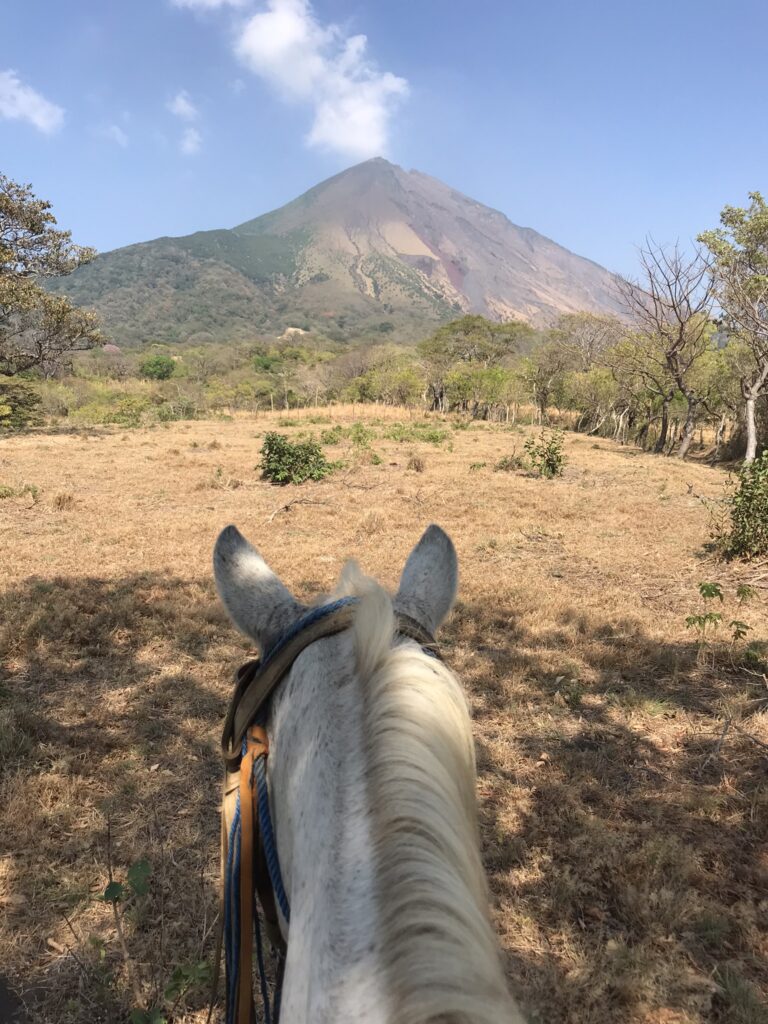
Ometepe is the largest island in Lake Nicaragua. The island is essentially formed by two volcanoes perched side-by-side in the waters of Lake Nicaragua. Maderas and Concepcion are ever-present icons/symbols of the island. Concepcion is the taller of the two at 1610m above sea level, making Ometepe the highest lake-island in the world. These remarkable volcanoes rest on either side of the hourglass-shaped island. From the isthmus connecting the two sides, it’s possible to see both volcanoes rising up from the earth. The island is also well-known for having interesting petroglyphs, especially spiral shapes, which can be found carved on rocks across the island.
The best way to get around the island is by scooter or ATV. The roads are in pretty bad shape in places, some of the surfaces are unpaved dirt tracks with potholes glore. There is a public bus which runs on a loop around the island roughly every 2 hours, but I would take the timings with a pinch of salt. It’s best to get your own transport so you can be mobile and more flexible with timings. You don’t want to be constrained by the bus timetable, I can only imagine how annoying it would be to time your visits to various places across the island according to the unreliable bus schedule.
Ometepe is quite a large island with several towns and villages, it takes a couple of hours to drive all the way around the island. We based ourselves in Moyogalpa and hired an ATV to get around, it worked well and we didn’t have any problems. We were worried that if we got stopped by the police they wouldn’t accept my UK driving license as I didn’t have an international one, but they didn’t seem bothered at all. I got stopped twice by the police at checkpoints, they checked my license and let me pass without any problems. Make sure you have your driving license or international driving permit with you at all times and easily accessible if you’re stopped. I really wouldn’t recommend hiring an ATV or scooter unless you have a license because I was unlucky enough to be stopped twice in one day. Always wear your helmet and don’t drive like an idiot otherwise the police will stop you and possibly try to extort you for a fine. Keep an eye out for cattle roaming across the road and unexpected speed bumps too.
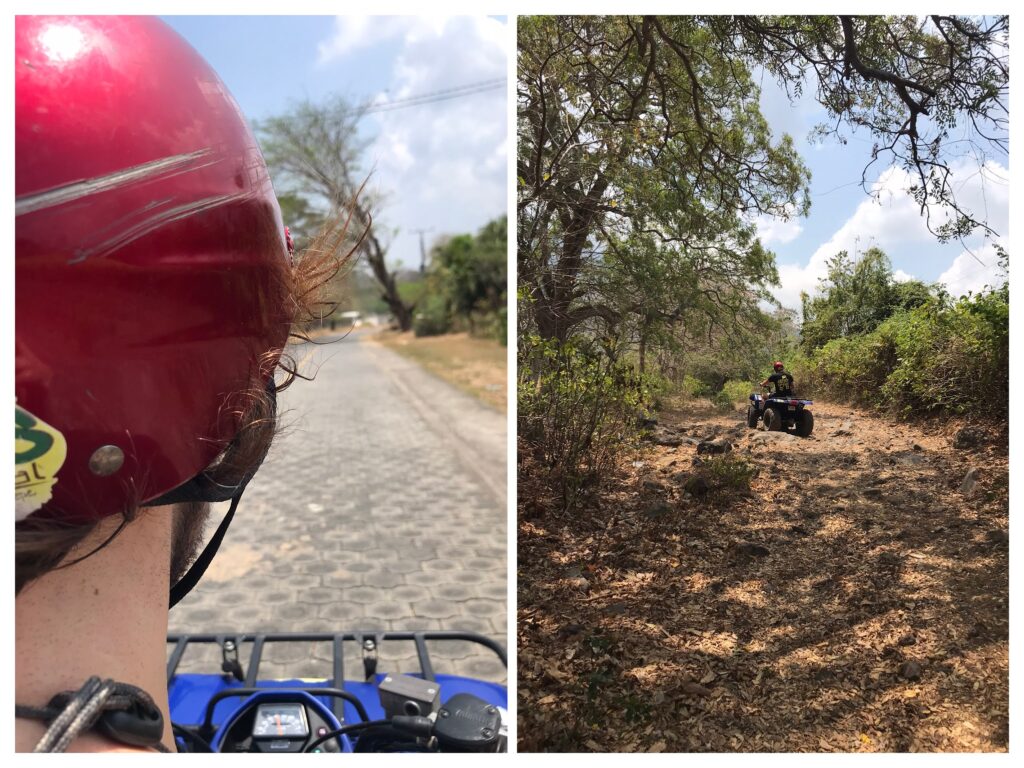
Believe it or not we still somehow managed to got lost even with only one main road around the island
Getting to Ometepe from Granada
There are two ways to get from Granada to Ometepe: you could opt to book a shared shuttle transfer which drops you off directly at the San Jorge harbor (costs around $15) or jump on the chicken bus to Rivas and then grab either a taxi or collectivo to the San Jorge pier. Which option you pick depends on your budget and preference. We picked the transfer and booked through Cueva Nica hostel in Granada instead of taking a public bus; this was because Dan was suffering from heatstroke and we didn’t mind paying a little extra for comfort. Once you arrive at the port, first you have to pay the port tax at the main gate and then queue up at the office to purchase your ferry ticket. You may have to wait for the next ferry which could be up to an hour. There is one cafe close to the boarding area if you want to grab some refreshments. If you want a good seat on the ferry, make sure you join the queue as early as possible. You don’t want to end up sitting in the aisle like we saw some fortunate souls forced to do.
It’s important to consider what kind of experience you’re looking for on Ometepe, this will affect where you stay on the island and what sort of accommodation you choose. Do you want to be within walking distance of amenities or would you prefer somewhere more off the beaten track? Are you looking for luxury or wanting to get as much value for money as possible? Do you want to be in the town centre or as far as possible away from it? These are some of the questions you need to ask yourself.
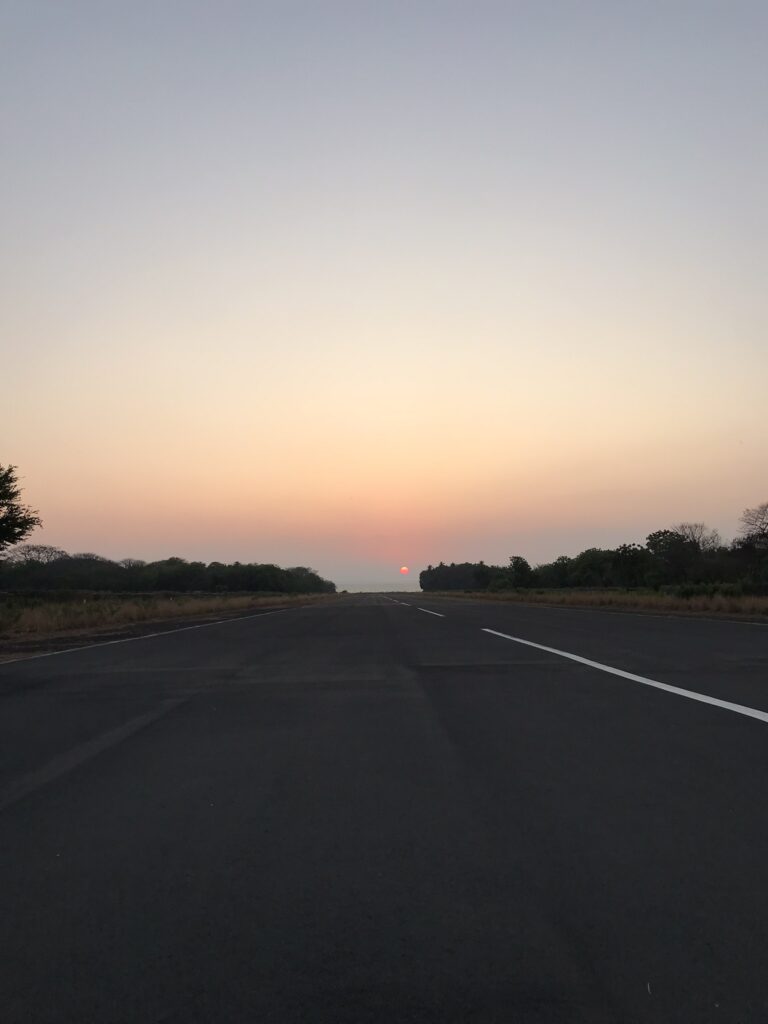
Did you know there’s an airport on Ometepe with a road running through the middle of the runway?
Moyogalpa is ideal if you want to be close to restaurants, supermarkets and tour agencies. It’s one of the two main towns on the island alongside Altagracia. By choosing to stay in Moyogalpa, you can walk to your accommodation after you arrive on the island as opposed to getting a taxi or hiring an ATV or scooter after you jump off the ferry. If you’re looking to stay in a remote location away from the hustle and bustle of the main town, I’d recommend finding somewhere else. There isn’t much nature to be seen in the town, only concrete roads and residential buildings.
Balgue is a popular alternative to Moyogalpa. Balgue has a good balance between being more secluded, away from the busy settlements of Moyogalpa and Altagracia and having some restaurants and shops to stock up on essentials. It’s known for having a relaxed vibe with a mix of upmarket ecolodges and more affordable hostels. Santa Cruz beach, El Pital and Café Campestre are great places to check out nearby. You need to find a way to get to Balgue from Moyogalpa after you exit the ferry. Consider hiring a scooter or ATV or catching the bus.
There are other options in more remote areas. You might not want to leave the hotel or hostel for every meal so consider if you’d be happy staying there for some meals. You would most definitely have to drive to supermarkets, pharmacies and other amenities in one of the two towns. If you’re looking to immerse yourself in nature this would be the best option for you.
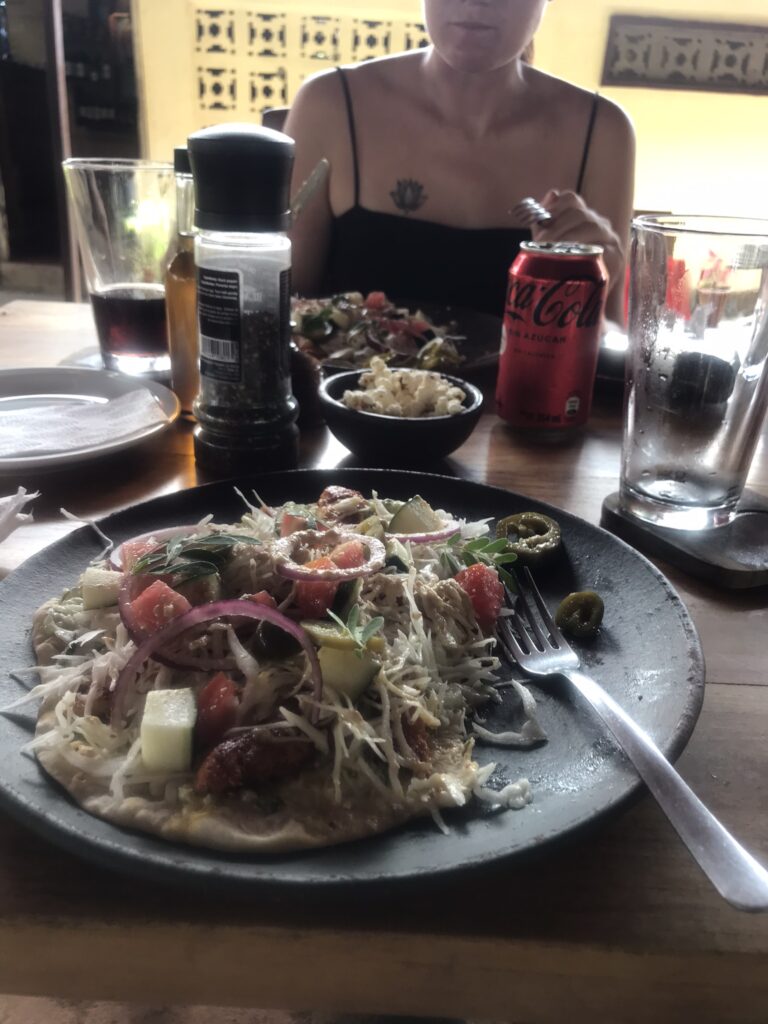
If you decide to stay in Balgue head to Cafe Campestre for lunch, you won’t be disappointed!
Accommodation
Hostal Eden – a new hostel close to the center of Moyogalpa. Breakfast is included as well as the use of a shared kitchen. The family that owns the hostel were helpful and very accommodating. Most importantly for us there was air-conditioning!
Foodie Places
Chido´s Pizza – cheap and cheerful pizza restaurant in the centre of Moyogalpa.
El Pital – the trendiest place to hang out on Ometepe complete with hanging swings and a private rocky shoreline with lake access. El Pital is a hostel/restaurant complex offering chocolate tasting sessions, cocoa ceremonies (I have no idea what this involves except the consumption of chocolate in some sort of ritual) and tasty chocolate-based cocktails by the lakeshore. Whilst waiting for your food and drinks you can take a refreshing dip in the lake or just watch the shimmering waters from the comfort of the wooden dock. We didn’t order any food but did notice that the prices were still quite affordable. El Pital is a lovely setting to sip on an iced chocolate and meet other like-minded travelers.

Unmissable views and atmosphere at El Pital
Café Campestre – Cafe Campestre is a great pit-stop for lunch if you find yourself in the area. The menu features homemade bread baked on-site and local artisanal products which you can buy in the attached shop. The menu is slightly more on the expensive side but you’re paying for the quality of the ingredients. We thoroughly enjoyed our chicken shawarma flatbreads.
Activities
The most popular things to do on Ometepe are to climb Concepcion or Maderas volcano. Concepcion is said to be the more challenging hike of the two whilst Maderas is slightly easier to summit. During March when we visited Concepcion was very cloudy, much to the disappointment of the brave tourists who dared summit the volcano. We didn’t want to overexert ourselves in the heat so we didn’t make the climb.
ATV hire with Elmer Tours – the guys at Elmer Tours were friendly and professional, they spoke excellent English and were happy to explain how to drive the ATV.
3-hour horse-riding tour with Elmer Tour – a fantastic leisurely horse-ride around the trails close to Concepcion volcano. The guide pointed out various fruits and animals along the way which was an unexpected treat. We even encountered some sleeping monkeys and I got involved with some cattle herding at one point when some cows appeared on the track in the opposite direction. Please bear in mind the guide doesn’t speak English so it might be a very quiet trek if you’re not well-versed in Spanish. Overall a positive experience!
Playa Santa Cruz – a quiet beach on the isthmus connecting the twin volcanoes, with stunning views from the beach of both volcanoes in the distance.
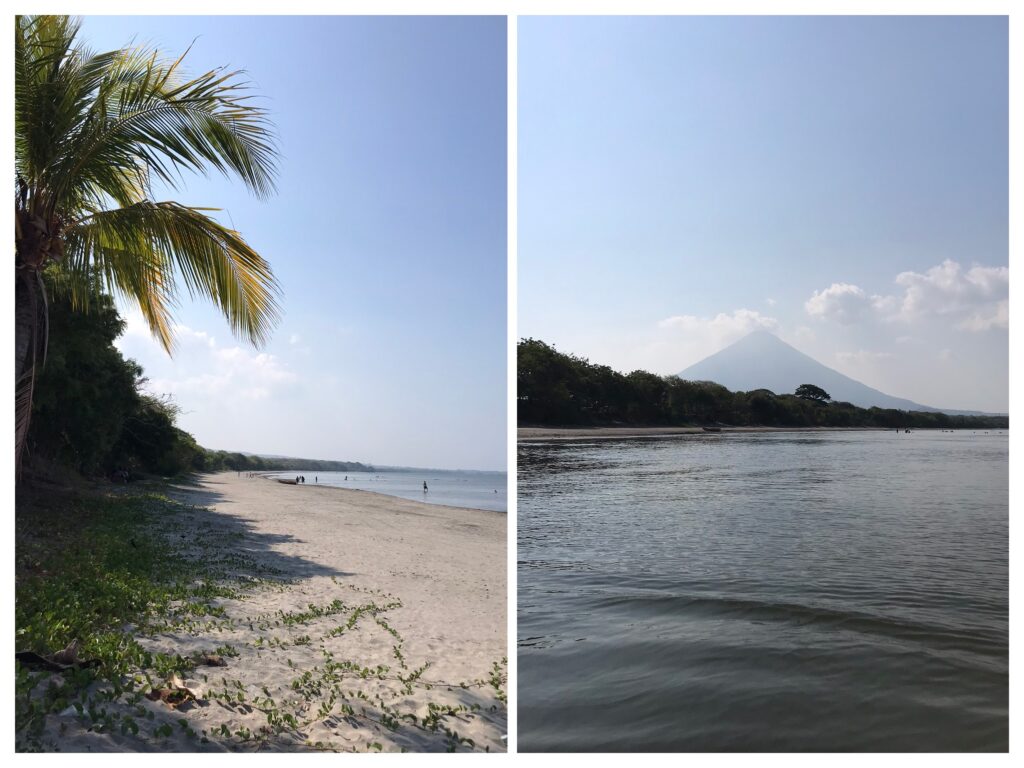
The water was so warm at Santa Cruz beach it was almost like taking a bath
Punta Jesús María – A black-sand beach on the western edge of Ometepe, a hotspot for locals and tourists alike. The beach is a great place to congregate at sunset and watch the sun slowly sinking into the horizon amid golden hues. The beach extends as a thin strip quite a distance into the lake, creating a pretty cool photo op.
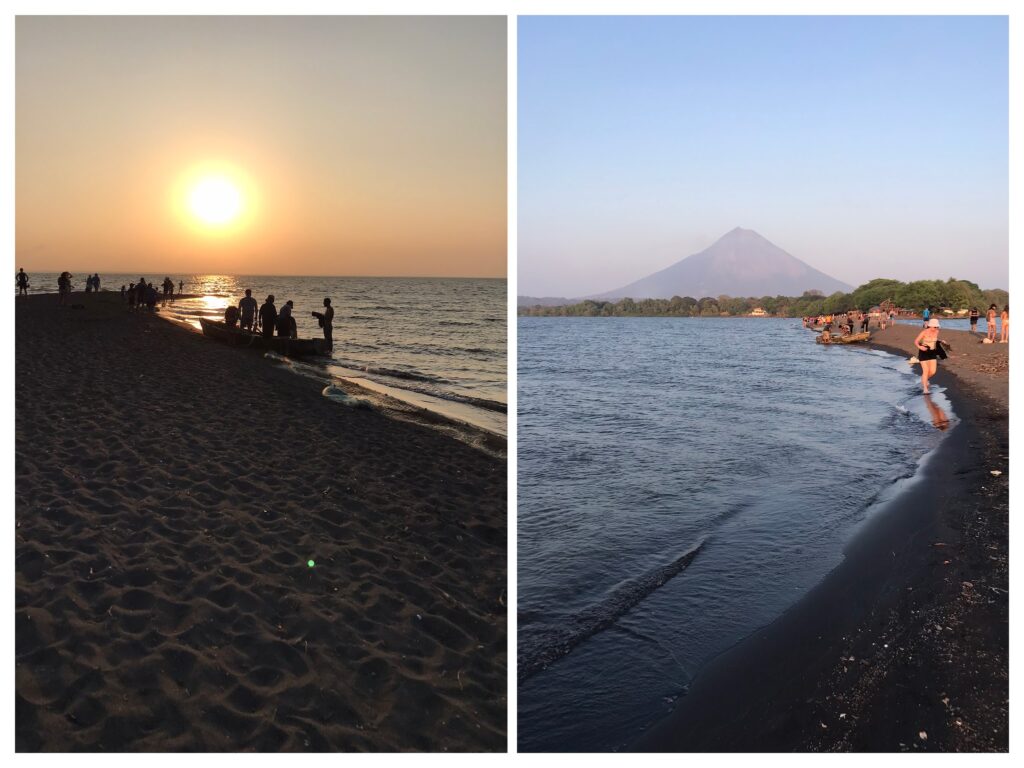
There’s no better time to visit Punta Jesús María than at sunset
Ojo de Agua – Worth a mention as it’s a top attraction on the island. We decided against visiting because you have to pay a $10 entrance fee and we’d already been to plenty of hot springs elsewhere.
After Nicaragua we headed to Costa Rica. Read about my experience crossing from Ometepe to San Jose here!
